Paul van Yperen's Blog, page 361
December 13, 2015
Ernst Matráy
Ernst Matráy (1891-1978) was a Hungarian dancer, choreographer, actor and film director. In Berlin, he worked with Max Reinhardt and Ernst Lubitsch. Together with his wife Maria Solveg, he later did the choreography for some classic Hollywood films.
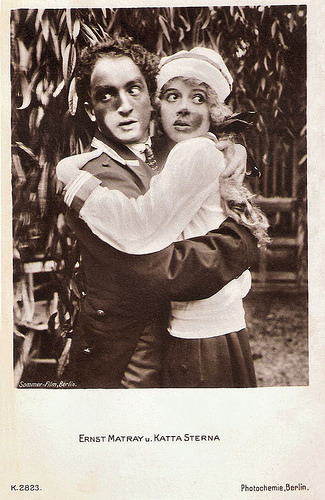
German postcard by Photochemie, Berlin, no. K.2823. Photo: Sommer Film, Berlin. Ernst Matray with Katta Sterna.
Quirky roles
Ernst Matráy (or Matray) was born as Erno Siblatt in Budapest, Austria-Hungary, in 1891. As a boy he had ballet lessons.
In 1907, he was spotted as a dancer by the famous German stage director Max Reinhardt. Reinhardt engaged him for Deutsche Theater in Berlin. Matráy worked there as an actor, dancer, choreographer and mime. He drew attention to himself in quirky roles that were specially written for him. In Sumurun (1908) he played a hunchback and in Das Mirakel/The Miracle (1911) a minstrel.
Matráy also appeared in film adaptations of Reinhardt productions such as Das Mirakel/The Miracle (Michel Carré, 1912), Die Insel der Seligen/The Isle of the Blessed (Max Reinhardt, 1913) and Eine venezianische Nacht/A Venetian Night (Max Reinhardt, 1913), so he was experienced with working for the camera early on.
Before and during the First World War, he was repeatedly seen as grotesque dancers in film comedies like Tangofieber/Tango Fever (Carl Wilhelm, 1913) with Albert Paulig , and Marionetten/Marionettes (Richard Löwenbein, 1915) with Katta Sterna. Matráy and Sterna often played together and they were an ideal film couple.
Matráy also directed several films, including Das Phantom der Oper/The Phantom of the Opera (Ernst Matráy, 1915) with Nils Chrisander , and Teufelchen/Little Devil (Ernst Matráy, 1915). In 1915, he founded Malu-film together with Ernst Lubitsch and produced Zucker und Zimt/Sugar and cinnamon (Ernst Lubitsch, 1915).
Matráy also worked as a screenwriter together with his first wife, Greta Schröder. He appeared in films like Hilde Warren und der Tod/Hilde Warren and Death (Joe May, 1917) based on a script by Fritz Lang, and Nathan der Weise/Nathan the Wise (Manfred Noa, 1922) with Werner Krauss . In 1922 he took over the artistic direction of the International Pantomime Company. With his ensemble he went on tour internationally.
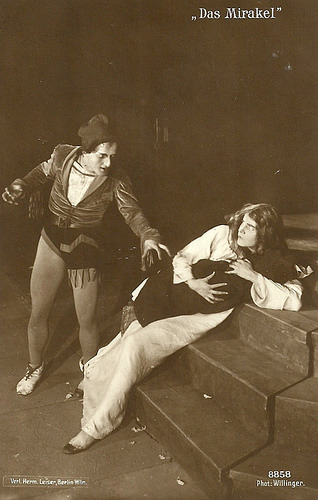
German postcard by Verlag Hermann Leiser, Berlin. no. 8858. Photo: Willinger. The photo was made for either the stage play Das Mirakel/The Miracle (1911) or the Austrian-British film Das Mirakel/The Miracle (1912). The card shows Ernst Matráy as the Evil Genius and, if the film, Florence Winston as Megildis, the nun who has escaped the convent and now has a baby. The Miracle was released in Germany in August 1914 and premiered at the Circus Busch. It had had its world premiere in Covent Garden, London, in 1912.
Choreography for Hollywood
In 1924 Ernst Matráy divorced Greta Schröder and in 1927 he married the actress Maria Solveg , who was the sister of his dance partner Katta Sterna. With his second wife, he worked for years on the development of ballet choreography.
After a last appearance of the Matray Ballet at the end of 1933 in the Ufa-Palast am Zoo, Matráy and Solveg emigrated via England to the United States. There the couple worked as choreographers for Revue troops. In order to get by financially the couple also sold apartments along the way.
Thanks to the German immigrant directors William Dieterle and Reinhold Schünzel , they could work on the choreography of some Hollywood films. These included The Hunchback of Notre Dame (William Dieterle, 1939) with Charles Laughton , Pride and Prejudice (Robert Z. Leonard, 1940) with Greer Garson , A Woman's Face (George Cukor, 1941), and Random Harvest (Mervyn LeRoy, 1942) with Ronald Colman .
Matráy was the co-director of the small compilation film Adventure in Music (Reginald LeBorg, S. K. Winston, Ernst Matray, 1944). Till 1945 he worked on 23 Hollywood films, often for MGM.
In 1953 the Matrays moved to Zurich in Switzerland. Matray staged at the Deutsches Schauspielhaus in Hamburg Molière's George Dandin and Jacques Offenbach's La vie parisienne (Parisian life). At the same time he worked as a choreographer for TV. He directed one more film Musik, Musik und nur Musik/Music, music and music only (Ernst Matray, 1955), starring Walter Giller and Inge Egger .
In 1955 he separated from Maria Solveg and returned to the United States. After the divorce in 1962, he married his third wife, the American Elizabeth McKinley. Later he devoted himself to painting. In 1978, Ernst Matray died of a heart attack in Los Angeles, California, USA.
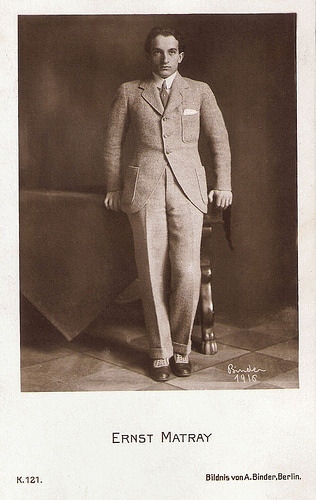
German postcard by Photochemie, Berlin, no. K.121. Photo: Alex Binder, 1916.
Source: Thomas Staedeli (Cyranos), Film-Zeit.de (German), Wikipedia (German) and .

German postcard by Photochemie, Berlin, no. K.2823. Photo: Sommer Film, Berlin. Ernst Matray with Katta Sterna.
Quirky roles
Ernst Matráy (or Matray) was born as Erno Siblatt in Budapest, Austria-Hungary, in 1891. As a boy he had ballet lessons.
In 1907, he was spotted as a dancer by the famous German stage director Max Reinhardt. Reinhardt engaged him for Deutsche Theater in Berlin. Matráy worked there as an actor, dancer, choreographer and mime. He drew attention to himself in quirky roles that were specially written for him. In Sumurun (1908) he played a hunchback and in Das Mirakel/The Miracle (1911) a minstrel.
Matráy also appeared in film adaptations of Reinhardt productions such as Das Mirakel/The Miracle (Michel Carré, 1912), Die Insel der Seligen/The Isle of the Blessed (Max Reinhardt, 1913) and Eine venezianische Nacht/A Venetian Night (Max Reinhardt, 1913), so he was experienced with working for the camera early on.
Before and during the First World War, he was repeatedly seen as grotesque dancers in film comedies like Tangofieber/Tango Fever (Carl Wilhelm, 1913) with Albert Paulig , and Marionetten/Marionettes (Richard Löwenbein, 1915) with Katta Sterna. Matráy and Sterna often played together and they were an ideal film couple.
Matráy also directed several films, including Das Phantom der Oper/The Phantom of the Opera (Ernst Matráy, 1915) with Nils Chrisander , and Teufelchen/Little Devil (Ernst Matráy, 1915). In 1915, he founded Malu-film together with Ernst Lubitsch and produced Zucker und Zimt/Sugar and cinnamon (Ernst Lubitsch, 1915).
Matráy also worked as a screenwriter together with his first wife, Greta Schröder. He appeared in films like Hilde Warren und der Tod/Hilde Warren and Death (Joe May, 1917) based on a script by Fritz Lang, and Nathan der Weise/Nathan the Wise (Manfred Noa, 1922) with Werner Krauss . In 1922 he took over the artistic direction of the International Pantomime Company. With his ensemble he went on tour internationally.

German postcard by Verlag Hermann Leiser, Berlin. no. 8858. Photo: Willinger. The photo was made for either the stage play Das Mirakel/The Miracle (1911) or the Austrian-British film Das Mirakel/The Miracle (1912). The card shows Ernst Matráy as the Evil Genius and, if the film, Florence Winston as Megildis, the nun who has escaped the convent and now has a baby. The Miracle was released in Germany in August 1914 and premiered at the Circus Busch. It had had its world premiere in Covent Garden, London, in 1912.
Choreography for Hollywood
In 1924 Ernst Matráy divorced Greta Schröder and in 1927 he married the actress Maria Solveg , who was the sister of his dance partner Katta Sterna. With his second wife, he worked for years on the development of ballet choreography.
After a last appearance of the Matray Ballet at the end of 1933 in the Ufa-Palast am Zoo, Matráy and Solveg emigrated via England to the United States. There the couple worked as choreographers for Revue troops. In order to get by financially the couple also sold apartments along the way.
Thanks to the German immigrant directors William Dieterle and Reinhold Schünzel , they could work on the choreography of some Hollywood films. These included The Hunchback of Notre Dame (William Dieterle, 1939) with Charles Laughton , Pride and Prejudice (Robert Z. Leonard, 1940) with Greer Garson , A Woman's Face (George Cukor, 1941), and Random Harvest (Mervyn LeRoy, 1942) with Ronald Colman .
Matráy was the co-director of the small compilation film Adventure in Music (Reginald LeBorg, S. K. Winston, Ernst Matray, 1944). Till 1945 he worked on 23 Hollywood films, often for MGM.
In 1953 the Matrays moved to Zurich in Switzerland. Matray staged at the Deutsches Schauspielhaus in Hamburg Molière's George Dandin and Jacques Offenbach's La vie parisienne (Parisian life). At the same time he worked as a choreographer for TV. He directed one more film Musik, Musik und nur Musik/Music, music and music only (Ernst Matray, 1955), starring Walter Giller and Inge Egger .
In 1955 he separated from Maria Solveg and returned to the United States. After the divorce in 1962, he married his third wife, the American Elizabeth McKinley. Later he devoted himself to painting. In 1978, Ernst Matray died of a heart attack in Los Angeles, California, USA.

German postcard by Photochemie, Berlin, no. K.121. Photo: Alex Binder, 1916.
Source: Thomas Staedeli (Cyranos), Film-Zeit.de (German), Wikipedia (German) and .
Published on December 13, 2015 22:00
December 12, 2015
Jacqueline Delubac
Pert, French star Jacqueline Delubac (1907-1997) was the third wife of actor, dramatist and film director Sacha Guitry. She starred in eleven of Guitry’s feathery comedies in which her husband co-starred. Between the two wars the charming actress was one of the most seductive stars of the French cinema. Life magazine rated her as one of the five most elegant women of the world.
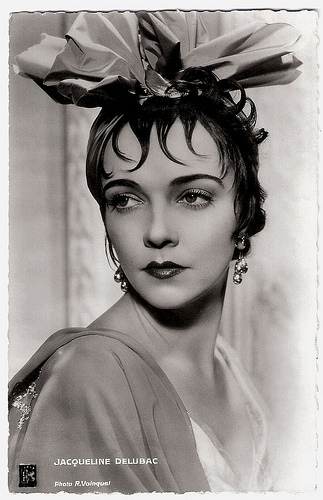
French postcard by Editions et Publications cinématographiques (EPC), no. 142. Photo: R. Voinquel.
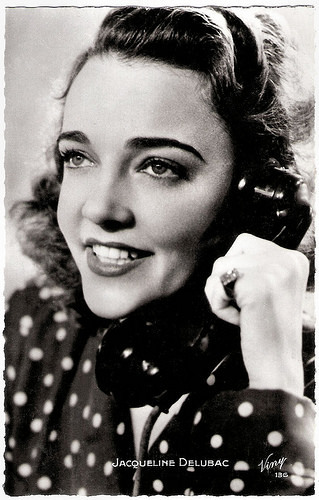
French postcard by Edug, Paris, no. 136. Photo: Viny.
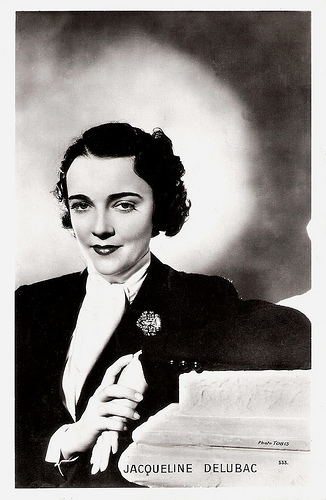
French postcard by Editions Chantal, Paris, no. 533. Photo: Tobis.
Young and Charming
Jacqueline Delubac was born as Isabelle Jacqueline Basset in Lyon, France, in 1907 (according to some sources 1910). She was the daughter of Isabelle Delubac, whose name she took, and Henri Basset, an industrialist. Her family had amassed a fortune from the manufacture of artificial silk.
From her earliest youth, however, her resolve was to become an actress. In 1927 she arrived in Paris to follow dance and singing courses.
She quickly found small roles in revues, and soon moved on to theatre and the cinema. She appeared in films like Chérie (Louis Mercanton, 1930) and Marions-nous/Let’s get Married (Louis Mercanton, 1931) with Fernand Gravey .
In Une brune piquante/A brunette (Serge de Poligny, 1931), she appeared with Fernandel. Then she joined the cast of Topaze (Louis J. Gasnier, 1932), based on the play by Marcel Pagnol and starring Louis Jouvet .
In the autumn of 1931 she was introduced to Sacha Guitry , who was looking for a young, charming actress to speak with an English accent in his play Villa à vendre (Villa For Sale). Guitry called her, engaged her and courted her discreetly. They married in 1935. At the time Guitry was 50 and Delubac only 28.
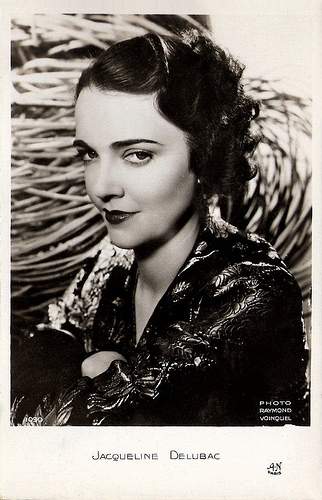
French postcard by AN, Paris, no. 1090. Photo: Raymond Voinquel.
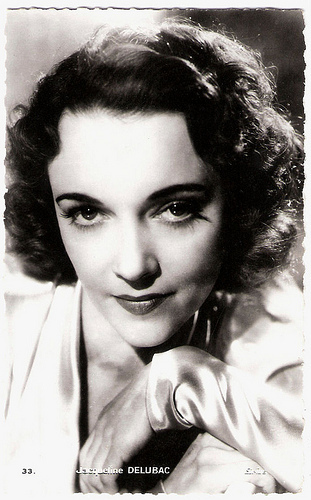
French postcard by Edit. Chantal, Roail, no. 33. Photo: Sipius.
Glamorous and Seductive
Sacha Guitry made a glamorous stage and cinema star of his young wife. Jacqueline Delubac starred in 23 plays by her husband, 10 new ones and 13 reprises, and appeared in 11 of his films.
Among these films are now classic film comedies like Bonne chance!/Good Luck (Sacha Guitry, Fernand Rivers, 1935) in which she played his gambling partner, Le Roman d'un tricheur/The Story of a Cheat (Sacha Guitry, 1936) with Roger Duchesne , Mon père avait raison/My Father Was Right (Sacha Guitry, 1936), Désiré (Sacha Guitry, 1937) and Quadrille (Sacha Guitry, 1938) with Gaby Morlay .
Her acting style in those films is remarkably natural and modern. Her wit and charms made her one of the most seductive French actresses between the two World Wars.
Her husband clothed her in the finest costumes and coats of the grand designers. She is considered to be the archetypal refined Parisian woman. The American magazine Life rated her as one of the five most elegant women of the world. She would keep up this elegance and refinement till the end of her life.
Gilbert Adair writes in his obituary for The Independent : "she was more than just a chic stooge. Even if one cannot abide Guitry's flamboyant urbanity and nasally whinnying delivery, it is possible to enjoy the dozen feathery comedies in which they co-starred (and all of which he directed) for their pert, soubrettish leading lady, with her near-supernatural vivacity, her deliciously retrousse nose, her oddly flapping lips - you have to see her deliver one of Guitry's mots to know what I am talking about - and her charming artlessness."
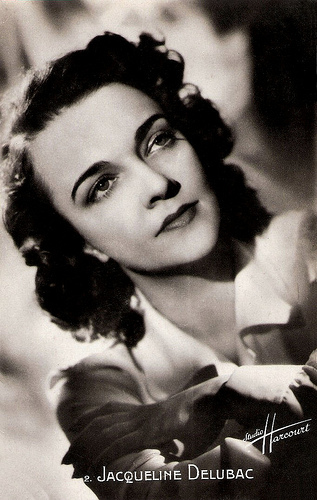
French postcard by SERP, Paris, no. 2. Photo: Studio Harcourt.
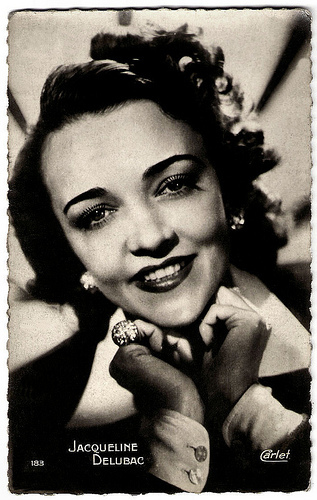
French postcard by Editions P.I., no. 183. Photo: Carlet.
Impressionist and Modernistic Art
In 1939, Jacqueline Delubac divorced Guitry. She played in a dozen more films by interesting directors.
Georg-Wilhelm Pabst directed her in Jeunes filles en détresse/Girls in Distress (1939) with Micheline Presle ). Maurice Tourneur was her director of Volpone (1940), Marcel L'Herbier for La Comédie du bonheur/The Comedy of happiness (1940) and Jean Delannoy for Fièvres/Fevers (1941) starring Tino Rossi .
Delubac also played in several stage plays. In 1940, a marriage with Leslie Hore-Belisha, a British politician and former War Secretary, was announced and then denied. After the war she married a diamond merchant of Armenian descent, Miran Eknayan.
In the early 1950s she retired. Her last film was the comedy La vie est un jeu/Life is a Game (Raymond Leboursier, 1951) with Jimmy Gaillard .
From then on she devoted herself to a remarkable collection of impressionist and modernistic art. Later she donated a large part of this collection, including paintings by Degas, Rodin, Renoir, Modigliani, Picasso and Bacon, to the Musée des Beaux-Arts of her native town Lyon. Her splendid costume collection of the 1960s till the 1990s was offered to the Musée de la Mode et du Textile in Paris.
Jacqueline Delubac died in 1997, in Créteil (Val-de-Marne), as a result of injuries sustained in an accident with a cyclist. She was 90.
French trailer for Le Roman d'un tricheur (1936). Source: Gaumont (YouTube).
French trailer for Faisons un rêve (1936). Source: Gaumont (YouTube).
Trailer for Jacqueline Delubac Expo Lyon. Source: Musée des Beaux-Arts de Lyon (YouTube).
Sources: Caroline Hanotte (CinéArtistes), Gilbert Adair (The Independent), Wikipedia (French), and .

French postcard by Editions et Publications cinématographiques (EPC), no. 142. Photo: R. Voinquel.

French postcard by Edug, Paris, no. 136. Photo: Viny.

French postcard by Editions Chantal, Paris, no. 533. Photo: Tobis.
Young and Charming
Jacqueline Delubac was born as Isabelle Jacqueline Basset in Lyon, France, in 1907 (according to some sources 1910). She was the daughter of Isabelle Delubac, whose name she took, and Henri Basset, an industrialist. Her family had amassed a fortune from the manufacture of artificial silk.
From her earliest youth, however, her resolve was to become an actress. In 1927 she arrived in Paris to follow dance and singing courses.
She quickly found small roles in revues, and soon moved on to theatre and the cinema. She appeared in films like Chérie (Louis Mercanton, 1930) and Marions-nous/Let’s get Married (Louis Mercanton, 1931) with Fernand Gravey .
In Une brune piquante/A brunette (Serge de Poligny, 1931), she appeared with Fernandel. Then she joined the cast of Topaze (Louis J. Gasnier, 1932), based on the play by Marcel Pagnol and starring Louis Jouvet .
In the autumn of 1931 she was introduced to Sacha Guitry , who was looking for a young, charming actress to speak with an English accent in his play Villa à vendre (Villa For Sale). Guitry called her, engaged her and courted her discreetly. They married in 1935. At the time Guitry was 50 and Delubac only 28.

French postcard by AN, Paris, no. 1090. Photo: Raymond Voinquel.

French postcard by Edit. Chantal, Roail, no. 33. Photo: Sipius.
Glamorous and Seductive
Sacha Guitry made a glamorous stage and cinema star of his young wife. Jacqueline Delubac starred in 23 plays by her husband, 10 new ones and 13 reprises, and appeared in 11 of his films.
Among these films are now classic film comedies like Bonne chance!/Good Luck (Sacha Guitry, Fernand Rivers, 1935) in which she played his gambling partner, Le Roman d'un tricheur/The Story of a Cheat (Sacha Guitry, 1936) with Roger Duchesne , Mon père avait raison/My Father Was Right (Sacha Guitry, 1936), Désiré (Sacha Guitry, 1937) and Quadrille (Sacha Guitry, 1938) with Gaby Morlay .
Her acting style in those films is remarkably natural and modern. Her wit and charms made her one of the most seductive French actresses between the two World Wars.
Her husband clothed her in the finest costumes and coats of the grand designers. She is considered to be the archetypal refined Parisian woman. The American magazine Life rated her as one of the five most elegant women of the world. She would keep up this elegance and refinement till the end of her life.
Gilbert Adair writes in his obituary for The Independent : "she was more than just a chic stooge. Even if one cannot abide Guitry's flamboyant urbanity and nasally whinnying delivery, it is possible to enjoy the dozen feathery comedies in which they co-starred (and all of which he directed) for their pert, soubrettish leading lady, with her near-supernatural vivacity, her deliciously retrousse nose, her oddly flapping lips - you have to see her deliver one of Guitry's mots to know what I am talking about - and her charming artlessness."

French postcard by SERP, Paris, no. 2. Photo: Studio Harcourt.

French postcard by Editions P.I., no. 183. Photo: Carlet.
Impressionist and Modernistic Art
In 1939, Jacqueline Delubac divorced Guitry. She played in a dozen more films by interesting directors.
Georg-Wilhelm Pabst directed her in Jeunes filles en détresse/Girls in Distress (1939) with Micheline Presle ). Maurice Tourneur was her director of Volpone (1940), Marcel L'Herbier for La Comédie du bonheur/The Comedy of happiness (1940) and Jean Delannoy for Fièvres/Fevers (1941) starring Tino Rossi .
Delubac also played in several stage plays. In 1940, a marriage with Leslie Hore-Belisha, a British politician and former War Secretary, was announced and then denied. After the war she married a diamond merchant of Armenian descent, Miran Eknayan.
In the early 1950s she retired. Her last film was the comedy La vie est un jeu/Life is a Game (Raymond Leboursier, 1951) with Jimmy Gaillard .
From then on she devoted herself to a remarkable collection of impressionist and modernistic art. Later she donated a large part of this collection, including paintings by Degas, Rodin, Renoir, Modigliani, Picasso and Bacon, to the Musée des Beaux-Arts of her native town Lyon. Her splendid costume collection of the 1960s till the 1990s was offered to the Musée de la Mode et du Textile in Paris.
Jacqueline Delubac died in 1997, in Créteil (Val-de-Marne), as a result of injuries sustained in an accident with a cyclist. She was 90.
French trailer for Le Roman d'un tricheur (1936). Source: Gaumont (YouTube).
French trailer for Faisons un rêve (1936). Source: Gaumont (YouTube).
Trailer for Jacqueline Delubac Expo Lyon. Source: Musée des Beaux-Arts de Lyon (YouTube).
Sources: Caroline Hanotte (CinéArtistes), Gilbert Adair (The Independent), Wikipedia (French), and .
Published on December 12, 2015 22:00
December 11, 2015
Imported from the USA: Grace Jones
Grace Jones (1948) is a Jamaican-born American singer, supermodel, and actress. Classic is her album Nightclubbing (1981) and unforgettable are her hits La Vie en Rose, Pull Up to the Bumper and I've Seen That Face Before. She was also memorable as a James Bond villain in A View to a Kill (1985). But foremost, the unusual, androgynous, bold, dark-skinned artist was a style icon for the late 1970s and early 1980s.
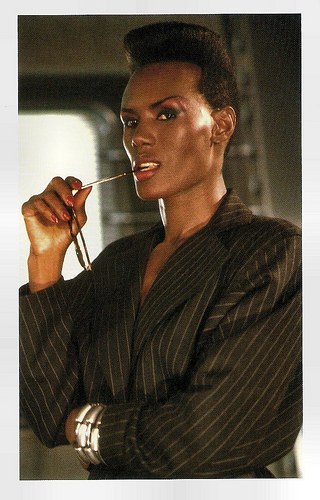
British postcard by Danjaq, LLC and United Artists Corporation. Photo: Grace Jones as May Day in A View to a Kill (John Glen, 1985).
Club Sept and Studio 54
Beverly Grace Jones was born in Spanish Town, Jamaica, in 1948. Her parents were Marjorie (née Williams) and Reverend Robert W. Jones, a local politician and Apostolic clergyman. Her grandfather (on her mother's side) was a musician who travelled with Nat 'King' Cole.
As her parents were working in the United States, Grace and her siblings were raised by her grandparents. Jones had a strict upbringing under the influence of Jamaica's Pentecostal church and went to church three times a week. At 13 she moved to her parents' home in Syracuse, New York. She studied theatre (some sources say Spanish) at Syracuse University. Halfway through college, a drama professor proposed her to work with him in a play he was putting on in Philadelphia, she accepted.
At 18, she moved back to New York, and signed on as a model with Wilhelmina Modelling agency. Her androgynous, dark-skinned looks were not successfully received in the USA, and in 1970, she moved to Paris, just like Josephine Baker had done 50 years before her.
In Paris, the fashion scene was receptive to Jones' unusual, bold appearance. Yves St. Laurent, Claude Montana, and Kenzo Takada hired her for runway modelling, and she appeared on the covers of Elle, Vogue, and Stern working with Helmut Newton, Guy Bourdin, and Hans Feurer.
Jones frequented Club Sept, one of Paris's most popular gay clubs of the 1970s and 1980s, and socialised with Giorgio Armani and Karl Lagerfeld. She also became one of the faces of New York City's hedonistic Studio 54 disco scene.
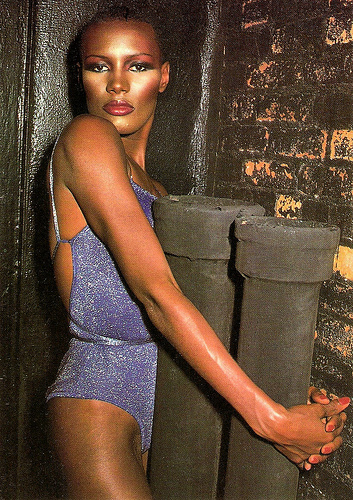
British postcard by Heroes, London, no. PC 544.
Queen of the Gay Discos
Grace Jones' statuesque and flamboyant look was such a hit in the New York City nightclub scene that she was signed by Island Records. They put her in the studio with disco record producer, Tom Moulton. In 1977 the album Portfolio,was released, which featured a seven-minute reinterpretation of Édith Piaf's La Vie en rose and finished with I Need a Man, Jones' first club hit. The artwork to the album was designed by Richard Bernstein, an artist for Interview.
In the following years, she made two more disco albums, Fame (1978) and Muse (1979). These two albums failed to break the singer commercially, but Jones amassed a substantial following among gay men with her sexually charged live show, leading to her title at the time of 'Queen of the Gay Discos.'
In 1980 Jones transitioned into New Wave music with the album Warm Leatherette, on which she collaborated with the Compass Point All Stars. The album included covers of songs by The Normal (Warm Leatherette), The Pretenders (Private Life), and Roxy Music (Love is the Drug).
The 1981 release of Nightclubbing included Jones' covers of songs by Iggy Pop/David Bowie (Nightclubbing) and Ástor Piazzolla (I've Seen That Face Before). Jones herself co-wrote Pull Up to the Bumper and Sting wrote Demolition Man. The strong rhythm of the album was produced by Compass Point All Stars, including Sly and Robbie.
The album entered in the Top 5 in four countries, and became Jones' highest-ranking record in the US. She scored Top 40 hits with Pull Up to the Bumper, and I've Seen That Face Before.
Another popular album was Slave to the Rhythm (1985), the last of her recordings for Island. In 1983, Jones' One Man Show was nominated for a Grammy Award for Best Long-Form Music Video. 1986's album Inside Story, with production chores by Chic's Nile Rodgers, spawned one of Jones' last successful singles, I'm Not Perfect (But I'm Perfect for You).
Music video for La Vie en rose (1977). Source: Lucifers Treasure (YouTube).
Music video for I've Seen That Face Before (Libertango) (1981). Source: Grace Jones VEVO (YouTube).
May Day
During the 1970s and early 1980s, Grace Jones appeared in some low-budget films. In the U.S., she appeared in the action film Gordon's War (Ossie Davis, 1973) starring Paul Winfield, and in Italy, she played a club singer in the Poliziottesco (Italian crime film genre) Quelli della Calibro 38/Colt 38 Special Squad (Massimo Dallamano, 1976) starring Marcel Bozzuffi and Carole André.
Her first mainstream film role was Zula the Amazonian in the fantasy-action film Conan the Destroyer (Richard Fleischer, 1984) alongside Arnold Schwarzenegger.
It was followed by her turn as May Day, henchman to villain Max Zorin (Christopher Walken) in the 14th James Bond film A View to a Kill (John Glen, 1985), featuring Roger Moore . With her boyfriend Dolph Lundgren, Jones posed nude for Playboy.
In 1986 she played as Katrina, an Egyptian queen vampire in the vampire film Vamp (Richard Wenk, 1986). The following year, Jones appeared in two films, Straight to Hell (Alex Cox, 1989), and Siesta (Mary Lambert, 1989) for which Jones was nominated for Golden Raspberry Award for Worst Supporting Actress.
She also acted in and contributed a song to the Eddie Murphy film Boomerang (Reginald Hudlin, 1993) and played in the Science Fiction film Cyber Bandits (Erik Fleming, 1995), starring Martin Kemp of the band Spandau Ballet. A decade later, she appeared as Christoph/Christine, an intersexed circus performer in the horror thriller Wolf Girl (Thom Fitzgerald, 2001) with Tim Curry.
As a style icon, Jones influenced the cross-dressing movement of the 1980s. She has been an inspiration for artists including Annie Lennox, Lady Gaga, Rihanna, Björk, Madonna, and Róisín Murphy.
Through her relationship with long-time collaborator Jean-Paul Goude, Jones has one son, Paulo. From Paulo, Jones has one granddaughter. Jones married Atila Altaunbay in 1996.
Bond 50 Trailer for A View to a Kill (John Glen, 1985). Source: Matthew Harkin (YouTube).
Trailer Vamp (Richard Wenk, 1986). Source: s flicks (YouTube).
Sources: Greg Prato (AllMusic), (IMDb), Wikipedia, and .

British postcard by Danjaq, LLC and United Artists Corporation. Photo: Grace Jones as May Day in A View to a Kill (John Glen, 1985).
Club Sept and Studio 54
Beverly Grace Jones was born in Spanish Town, Jamaica, in 1948. Her parents were Marjorie (née Williams) and Reverend Robert W. Jones, a local politician and Apostolic clergyman. Her grandfather (on her mother's side) was a musician who travelled with Nat 'King' Cole.
As her parents were working in the United States, Grace and her siblings were raised by her grandparents. Jones had a strict upbringing under the influence of Jamaica's Pentecostal church and went to church three times a week. At 13 she moved to her parents' home in Syracuse, New York. She studied theatre (some sources say Spanish) at Syracuse University. Halfway through college, a drama professor proposed her to work with him in a play he was putting on in Philadelphia, she accepted.
At 18, she moved back to New York, and signed on as a model with Wilhelmina Modelling agency. Her androgynous, dark-skinned looks were not successfully received in the USA, and in 1970, she moved to Paris, just like Josephine Baker had done 50 years before her.
In Paris, the fashion scene was receptive to Jones' unusual, bold appearance. Yves St. Laurent, Claude Montana, and Kenzo Takada hired her for runway modelling, and she appeared on the covers of Elle, Vogue, and Stern working with Helmut Newton, Guy Bourdin, and Hans Feurer.
Jones frequented Club Sept, one of Paris's most popular gay clubs of the 1970s and 1980s, and socialised with Giorgio Armani and Karl Lagerfeld. She also became one of the faces of New York City's hedonistic Studio 54 disco scene.

British postcard by Heroes, London, no. PC 544.
Queen of the Gay Discos
Grace Jones' statuesque and flamboyant look was such a hit in the New York City nightclub scene that she was signed by Island Records. They put her in the studio with disco record producer, Tom Moulton. In 1977 the album Portfolio,was released, which featured a seven-minute reinterpretation of Édith Piaf's La Vie en rose and finished with I Need a Man, Jones' first club hit. The artwork to the album was designed by Richard Bernstein, an artist for Interview.
In the following years, she made two more disco albums, Fame (1978) and Muse (1979). These two albums failed to break the singer commercially, but Jones amassed a substantial following among gay men with her sexually charged live show, leading to her title at the time of 'Queen of the Gay Discos.'
In 1980 Jones transitioned into New Wave music with the album Warm Leatherette, on which she collaborated with the Compass Point All Stars. The album included covers of songs by The Normal (Warm Leatherette), The Pretenders (Private Life), and Roxy Music (Love is the Drug).
The 1981 release of Nightclubbing included Jones' covers of songs by Iggy Pop/David Bowie (Nightclubbing) and Ástor Piazzolla (I've Seen That Face Before). Jones herself co-wrote Pull Up to the Bumper and Sting wrote Demolition Man. The strong rhythm of the album was produced by Compass Point All Stars, including Sly and Robbie.
The album entered in the Top 5 in four countries, and became Jones' highest-ranking record in the US. She scored Top 40 hits with Pull Up to the Bumper, and I've Seen That Face Before.
Another popular album was Slave to the Rhythm (1985), the last of her recordings for Island. In 1983, Jones' One Man Show was nominated for a Grammy Award for Best Long-Form Music Video. 1986's album Inside Story, with production chores by Chic's Nile Rodgers, spawned one of Jones' last successful singles, I'm Not Perfect (But I'm Perfect for You).
Music video for La Vie en rose (1977). Source: Lucifers Treasure (YouTube).
Music video for I've Seen That Face Before (Libertango) (1981). Source: Grace Jones VEVO (YouTube).
May Day
During the 1970s and early 1980s, Grace Jones appeared in some low-budget films. In the U.S., she appeared in the action film Gordon's War (Ossie Davis, 1973) starring Paul Winfield, and in Italy, she played a club singer in the Poliziottesco (Italian crime film genre) Quelli della Calibro 38/Colt 38 Special Squad (Massimo Dallamano, 1976) starring Marcel Bozzuffi and Carole André.
Her first mainstream film role was Zula the Amazonian in the fantasy-action film Conan the Destroyer (Richard Fleischer, 1984) alongside Arnold Schwarzenegger.
It was followed by her turn as May Day, henchman to villain Max Zorin (Christopher Walken) in the 14th James Bond film A View to a Kill (John Glen, 1985), featuring Roger Moore . With her boyfriend Dolph Lundgren, Jones posed nude for Playboy.
In 1986 she played as Katrina, an Egyptian queen vampire in the vampire film Vamp (Richard Wenk, 1986). The following year, Jones appeared in two films, Straight to Hell (Alex Cox, 1989), and Siesta (Mary Lambert, 1989) for which Jones was nominated for Golden Raspberry Award for Worst Supporting Actress.
She also acted in and contributed a song to the Eddie Murphy film Boomerang (Reginald Hudlin, 1993) and played in the Science Fiction film Cyber Bandits (Erik Fleming, 1995), starring Martin Kemp of the band Spandau Ballet. A decade later, she appeared as Christoph/Christine, an intersexed circus performer in the horror thriller Wolf Girl (Thom Fitzgerald, 2001) with Tim Curry.
As a style icon, Jones influenced the cross-dressing movement of the 1980s. She has been an inspiration for artists including Annie Lennox, Lady Gaga, Rihanna, Björk, Madonna, and Róisín Murphy.
Through her relationship with long-time collaborator Jean-Paul Goude, Jones has one son, Paulo. From Paulo, Jones has one granddaughter. Jones married Atila Altaunbay in 1996.
Bond 50 Trailer for A View to a Kill (John Glen, 1985). Source: Matthew Harkin (YouTube).
Trailer Vamp (Richard Wenk, 1986). Source: s flicks (YouTube).
Sources: Greg Prato (AllMusic), (IMDb), Wikipedia, and .
Published on December 11, 2015 22:00
December 10, 2015
EFSP's Dazzling Dozen: Odd Characters
That guy... who was in that film... Know what I mean? You saw the film, forgot the leads, but kept remembering that odd face of the boss, neighbour, uncle. These funny characters were superbly played by little-known supporting actors. Today EFSP brings a salute to 12 of these great character actors.
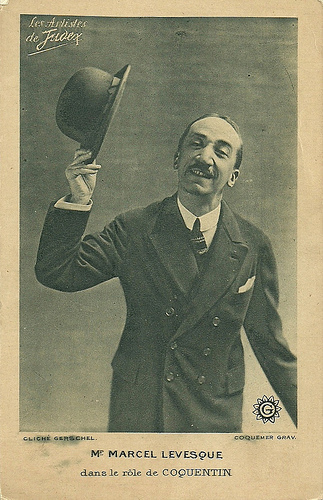
French postcard by Coquemer Gravures, Paris. Photo: Gerschel / Gaumont. Still for La nouvelle mission de Judex (Louis Feuillade, 1917-1918).
Marcel Lévesque (1877-1962) was a French actor and scriptwriter who excelled in French silent and sound comedies but also played memorable parts in the crime serials by Feuillade and in Renoir’s Le crime de M. Lange.
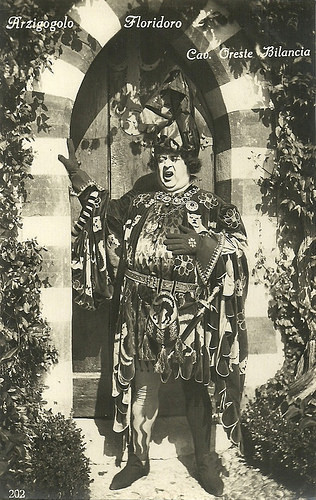
Italian postcard by Ed. Ballerini & Fratini, Firenze, no. 202. Photo: Negativi Alba Film. Publicity still for L'arzigogolo (Mario Almirante, 1924).
Stage and film actor Oreste Bilancia (1881-1945) was highly active in Italian silent and sound cinema and also in the late silent cinema of the Weimar republic. He mostly worked as a supporting actor, but occasionally he played the main character.
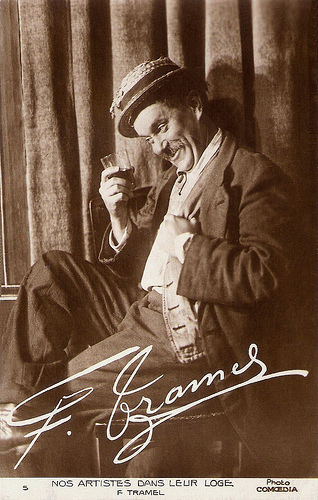
French postcard in the series Nos artistes dans leur loge, no. 5. Sent by mail in 1923. Photo: Comoedia.
Félicien Tramel (1880-1948) was a French singer and actor. He made more than 30 78’s at Odeon with such hits as T'en fais pas Bouboule (Do not worry Bouboule) and Y me faut mon patelin (I miss my hometown). Between 1911 and 1947 he played in dozens of films. In a series of silent and sound comedies he starred as the character Alfred Bicard or le Bouif.
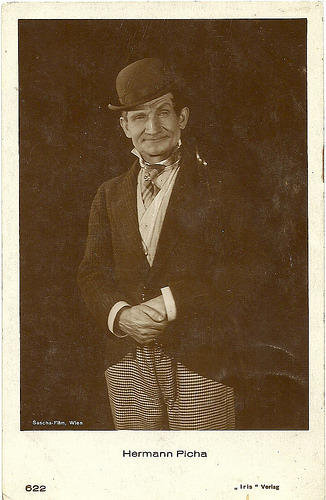
Austrian postcard by Iris-Verlag, no. 522. Photo: Sascha-Film, Wien (Vienna). Collection: Didier Hanson.
German actor Hermann Picha (1865-1936) played character roles in many classics of the Weimar cinema, such as Fritz Lang's Der müde Tod/Destiny (1921), F.W. Murnau's Herr Tartüff/Tartuffe (1925), and Der Hauptmann von Köpenick/The Captain from Koepenick (Siegfried Dessauer, 1926).
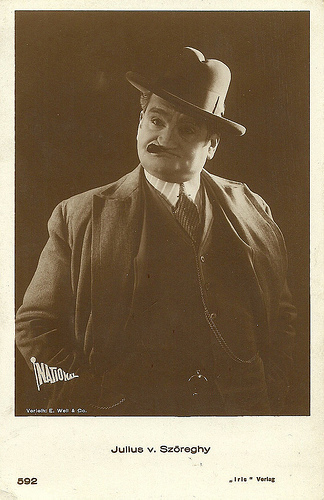
Austrian postcard by Iris Verlag, no. 592. Photo: Verleih E. Weill & Co. / National. Collection: Didier Hanson.
Hungarian actor and film director Julius von Szöreghy (1883-1943) was one of the busiest supporting actors of the German and Austrian cinema in the second half of the 1920s.
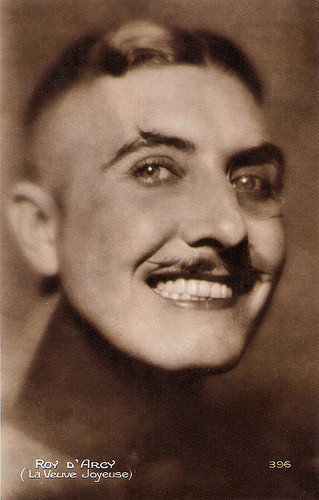
French postcard by Cinémagazine-Edition, Paris, no. 396. Photo: publicity still for The Merry Widow (Erich Von Stroheim, 1925).
American character actor Roy d'Arcy played his most famous role in Erich Von Stroheim’s classic The Merry Widow (1925), starring Mae Murray and John Gilbert.
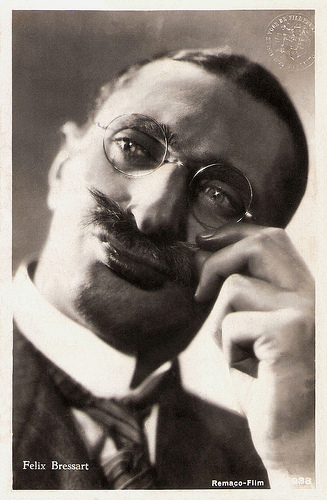
Dutch postcard, no. 238. Photo: Remaco-Film. At the rop right is a censorship stamp, necessary in the Netherlands for all film photos at the time.
German stage and screen actor Felix Bressart (1892–1949) had to flee Germany after the Nazis seized to power. He continued his film career in Austria and later in the US, where he became a popular character actor for MGM.
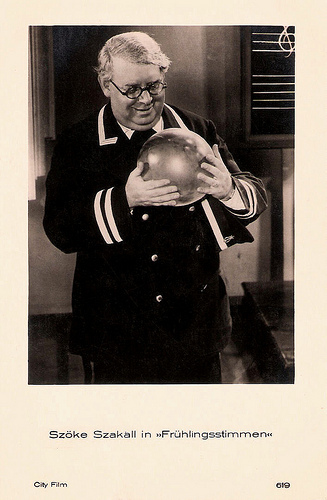
Dutch postcard by City Film, no. 619. Photo: publicity still for Frühlingsstimmen/Voices of Springtime (1933, Pál Fejös).
Cute, chubby-jowled Hungarian actor Szöke Szakáll (1883-1955) started his film career in the German and Austrian silent cinema. From 1940 on, he became known as S.Z. Sakall in Hollywood. He was memorable as Carl, the waiter in Casablanca (Michael Curtiz, 1942) and played many more supporting roles in comedies and musicals, often as a lovable somewhat befuddled uncle, businessman or neighborhood eccentric.
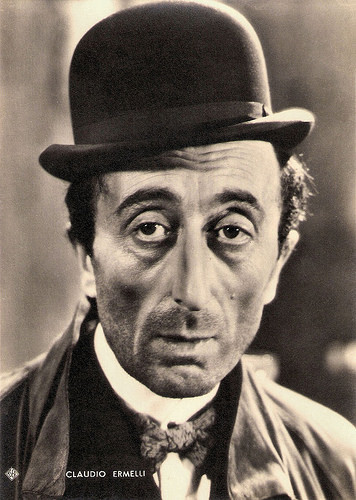
Italian postcard by ASER, Roma, no. 97. Photo: Pesce.
Italian film actor Claudio Ermelli (1892-1964) played bit parts and character roles in more than 115 films, from 1915 to 1962.
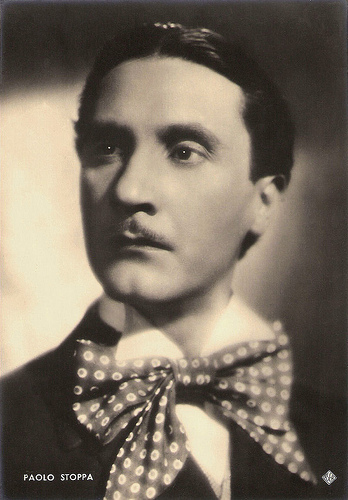
Italian postcard by ASER (A. Scarmiglia Ed., Roma), no. 96. Photo: Pesce.
Italian character actor Paolo Stoppa (1906–1988) is best known for his stage work with director Luchino Visconti. In a career of more than 50 years, he also appeared in such cinema classics as Miracolo a Milano (1951), Il Gattopardo (1962) and Once Upon a Time in the West (1968).
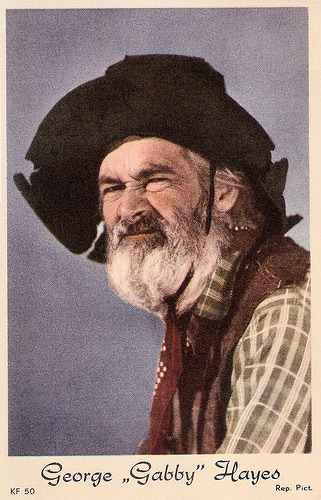
Dutch postcard, no. KF 50. Photo: Republic Pictures.
American character actor George 'Gabby' Hayes (1885-1969) was one of the colourful sidekicks to the leading men in the Hollywood Westerns of the 1930s and 1940s. His grizzled codger was so popular that Hayes landed repeatedly on the annual list of Top Ten Western Box-office Stars.
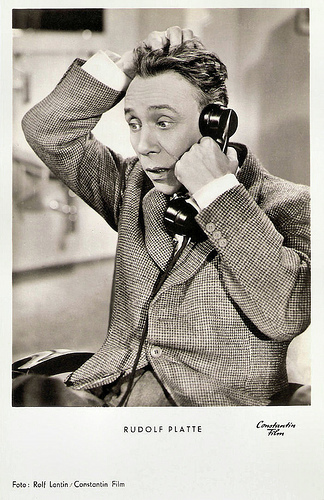
German postcard by Kunst und Bild, Berlin. Photo: Rolf Lantin / Constantin-Film.
German character actor Rudolf Platte (1904-1984) played both cheerfully talkative and reserved and shy, but loving people in more than 200 films. After his death, the media hailed him as Berlin’s ‘last true folk actor’.
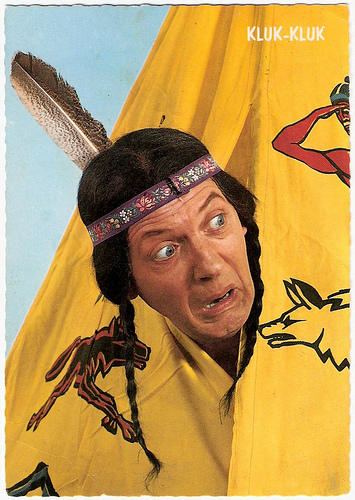
Dutch postcard by Gebr. Spanjersberg N.V., Rotterdam. Sent by mail in 1969. Photo: Herbert Joeks in Pipo de clown.
Frail singer and character actor Herbert Joeks (1915-1993) appeared in several Dutch films and TV series. He became an icon for generations of Dutch kids as the fearful Indian Klukkluk in the TV-series Pipo de Clown (1958-1980).
This is a post for Postcard Friendship Friday, hosted by Beth at the The Best Hearts are Crunchy. You can visit her by clicking on the button below.


French postcard by Coquemer Gravures, Paris. Photo: Gerschel / Gaumont. Still for La nouvelle mission de Judex (Louis Feuillade, 1917-1918).
Marcel Lévesque (1877-1962) was a French actor and scriptwriter who excelled in French silent and sound comedies but also played memorable parts in the crime serials by Feuillade and in Renoir’s Le crime de M. Lange.

Italian postcard by Ed. Ballerini & Fratini, Firenze, no. 202. Photo: Negativi Alba Film. Publicity still for L'arzigogolo (Mario Almirante, 1924).
Stage and film actor Oreste Bilancia (1881-1945) was highly active in Italian silent and sound cinema and also in the late silent cinema of the Weimar republic. He mostly worked as a supporting actor, but occasionally he played the main character.

French postcard in the series Nos artistes dans leur loge, no. 5. Sent by mail in 1923. Photo: Comoedia.
Félicien Tramel (1880-1948) was a French singer and actor. He made more than 30 78’s at Odeon with such hits as T'en fais pas Bouboule (Do not worry Bouboule) and Y me faut mon patelin (I miss my hometown). Between 1911 and 1947 he played in dozens of films. In a series of silent and sound comedies he starred as the character Alfred Bicard or le Bouif.

Austrian postcard by Iris-Verlag, no. 522. Photo: Sascha-Film, Wien (Vienna). Collection: Didier Hanson.
German actor Hermann Picha (1865-1936) played character roles in many classics of the Weimar cinema, such as Fritz Lang's Der müde Tod/Destiny (1921), F.W. Murnau's Herr Tartüff/Tartuffe (1925), and Der Hauptmann von Köpenick/The Captain from Koepenick (Siegfried Dessauer, 1926).

Austrian postcard by Iris Verlag, no. 592. Photo: Verleih E. Weill & Co. / National. Collection: Didier Hanson.
Hungarian actor and film director Julius von Szöreghy (1883-1943) was one of the busiest supporting actors of the German and Austrian cinema in the second half of the 1920s.

French postcard by Cinémagazine-Edition, Paris, no. 396. Photo: publicity still for The Merry Widow (Erich Von Stroheim, 1925).
American character actor Roy d'Arcy played his most famous role in Erich Von Stroheim’s classic The Merry Widow (1925), starring Mae Murray and John Gilbert.

Dutch postcard, no. 238. Photo: Remaco-Film. At the rop right is a censorship stamp, necessary in the Netherlands for all film photos at the time.
German stage and screen actor Felix Bressart (1892–1949) had to flee Germany after the Nazis seized to power. He continued his film career in Austria and later in the US, where he became a popular character actor for MGM.

Dutch postcard by City Film, no. 619. Photo: publicity still for Frühlingsstimmen/Voices of Springtime (1933, Pál Fejös).
Cute, chubby-jowled Hungarian actor Szöke Szakáll (1883-1955) started his film career in the German and Austrian silent cinema. From 1940 on, he became known as S.Z. Sakall in Hollywood. He was memorable as Carl, the waiter in Casablanca (Michael Curtiz, 1942) and played many more supporting roles in comedies and musicals, often as a lovable somewhat befuddled uncle, businessman or neighborhood eccentric.

Italian postcard by ASER, Roma, no. 97. Photo: Pesce.
Italian film actor Claudio Ermelli (1892-1964) played bit parts and character roles in more than 115 films, from 1915 to 1962.

Italian postcard by ASER (A. Scarmiglia Ed., Roma), no. 96. Photo: Pesce.
Italian character actor Paolo Stoppa (1906–1988) is best known for his stage work with director Luchino Visconti. In a career of more than 50 years, he also appeared in such cinema classics as Miracolo a Milano (1951), Il Gattopardo (1962) and Once Upon a Time in the West (1968).

Dutch postcard, no. KF 50. Photo: Republic Pictures.
American character actor George 'Gabby' Hayes (1885-1969) was one of the colourful sidekicks to the leading men in the Hollywood Westerns of the 1930s and 1940s. His grizzled codger was so popular that Hayes landed repeatedly on the annual list of Top Ten Western Box-office Stars.

German postcard by Kunst und Bild, Berlin. Photo: Rolf Lantin / Constantin-Film.
German character actor Rudolf Platte (1904-1984) played both cheerfully talkative and reserved and shy, but loving people in more than 200 films. After his death, the media hailed him as Berlin’s ‘last true folk actor’.

Dutch postcard by Gebr. Spanjersberg N.V., Rotterdam. Sent by mail in 1969. Photo: Herbert Joeks in Pipo de clown.
Frail singer and character actor Herbert Joeks (1915-1993) appeared in several Dutch films and TV series. He became an icon for generations of Dutch kids as the fearful Indian Klukkluk in the TV-series Pipo de Clown (1958-1980).
This is a post for Postcard Friendship Friday, hosted by Beth at the The Best Hearts are Crunchy. You can visit her by clicking on the button below.

Published on December 10, 2015 22:00
December 9, 2015
Marisa Allasio
Marisa Allasio (1936) was a glamorous starlet who appeared in nearly twenty pictures in the 1950s. She was nicknamed ‘The Italian Jayne Mansfield’. In 1958 her career stopped abruptly when she married and became a countess.

Italian postcard by Rotalcolor, no. 1.
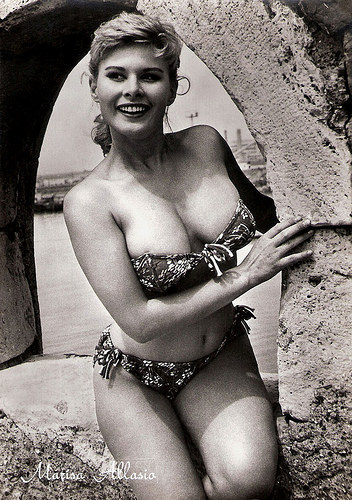
Italian postcard by Rotalfoto, no. 714.
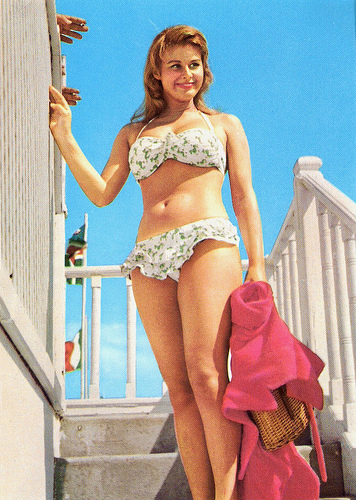
Italian postcard by Rotalfoto, no. R. 107.
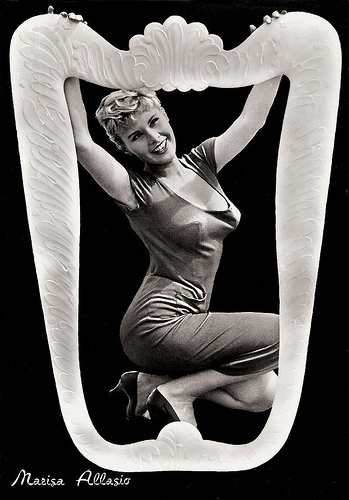
Italian postcard by SA Poligrafica Sammarinese, no. 020-d.
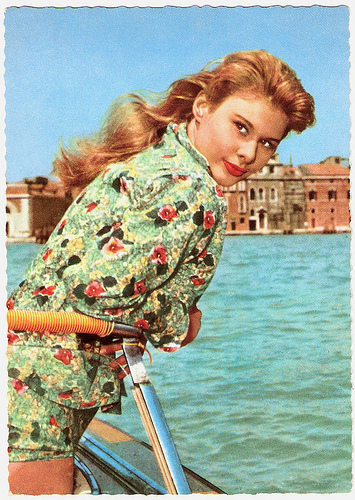
German postcard by Universum-Film Aktiengesellschaft (UFA), Berlin-Tempelhof, no. CK-174. Retail price: 30 Pfg. Photo: G.B. Poletto / UFA.
Miss Lido
Marisa Allasio was born Maria Luisa Lucia Allasio in Turin in 1936. She was the daughter of Federico Allasio, road contractor, goalkeeper of the Torino soccer team ánd coach of many Italian soccer teams, and his wife Lucia Rocchietti.
At 14, she was crowned Miss Lido, winning her first and only beauty contest. When Italian magazines published pin-up art of 'Miss Lido,' she was transferred to a public school.
At 16, Marisa made her film debut in a bit part in the melodrama Perdonami!/Forgive me (Mario Costa, 1952) starring Raf Vallone and Antonella Lualdi. She talked her parents into enrolling her in Rome’s Academy of Dramatic Arts.
The following years she appeared in Italian film productions like the soccer film Gli eroi della domenica/The Sunday Heroes (Mario Camerini, 1953) starring Raf Vallone and Marcello Mastroianni, Cuore di mamma/Mother's Heart (Luigi Capuano, 1954), and Ragazze d'oggi/Girls of Today (Luigi Zampa, 1955).
She also had an uncredited part in the international epic War and Peace (King Vidor, 1956) based on the famous novel by Leo Tolstoy and starring Audrey Hepburn , Henry Fonda and Mel Ferrer.
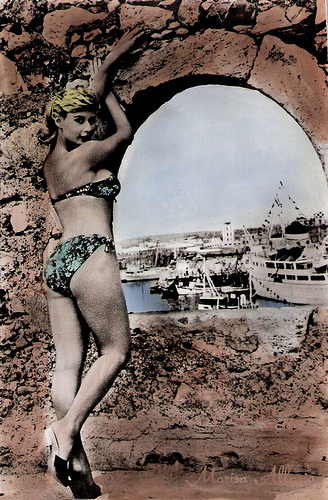
Yugoslavian postcard.
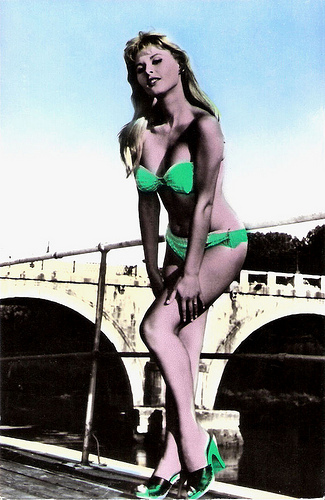
Yugoslavian postcard by Studio Sombor, no. 213.
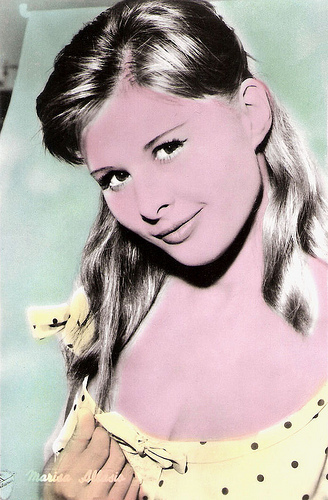
Yugoslavian postcard by Studio Sombor, no. 300.

Italian postcard. Publicity still for Ragazze d'oggi/Girls of Today (Luigi Zampa, 1955) with Mike Bongiorno .
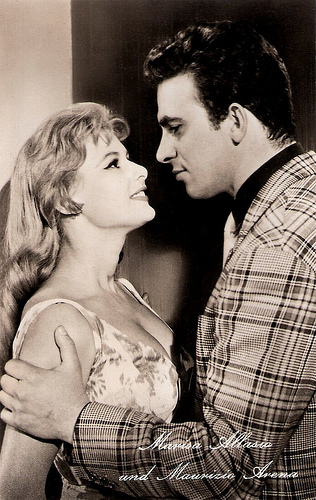
With Maurizio Arena. East-German postcard by VEB Progress Film-Vertrieb, Berlin, no. 1355, 1960. Retail price: 0,20 DM. Photo: Progress.
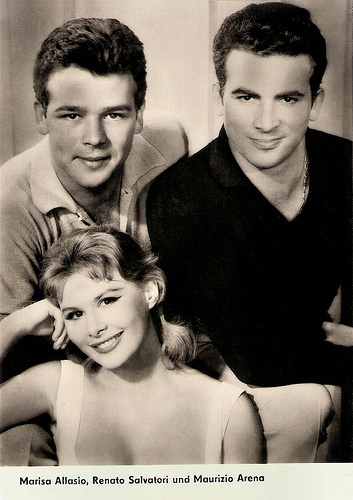
East-German postcard by VEB Progress Film-Vertrieb, Berlin, no. 1356, 1961. Retail price: 0,20 DM. Photo: Progress. Publicity still for Poveri ma belli/Poor But Beautiful (Dino Risi, 1957) with Renato Salvatori and Maurizio Arena.
Bikini Girl
Marisa Allasio had her breakthrough as Giovanna in the comedy Poveri ma belli/Poor But Beautiful (Dino Risi, 1956) opposite Renato Salvatori and Maurizio Arena and the sequel Belle ma povere/Poor Girl, Pretty Girl (Dino Risi, 1957).
Her part wins her national notoriety when the Pope condemns posters advertising it as 'overly exciting.' The posters are seized by Italian police. Despite this scandal she became popular as ‘la ragazza bella’, with her amazing curves clad in a bikini.
She appeared as the main attraction in comedies like Marisa la civetta/Marisa (Mauro Bolognini, 1957) again with Renato Salvatori , Camping (Franco Zeffirelli, 1957), Susanna tutta panna/Susanna, you whipped cream (Steno, 1957), and Venezia, la luna e tu/Venice, the Moon and You (Dino Risi, 1958) with Alberto Sordi .
As a pin-up she became hugely popular. In 1957 she was on the cover of Modern Man Quarterly Fall 1957, and an international breakthrough seemed only a matter of time. She appeared in the German-Italian coproduction Nackt, wie Gott sie schuf/Naked Like God Created Her (Hans Schott-Schöbinger, 1958), and the American-Italian Mario Lanza vehicle Seven Hills of Rome (Roy Rowland, 1958). But that would be her final film.
In 1958 she married Conte Pierfrancesco Calvi. Her husband is the 7th count of Bèrgolo, Head of the Calvi di Bèrgolo Family, since 1977. His mother was a daughter of H.R.M. Vittorio Emanuele III, King of Italy, King of Albania and Emperor of Ethiopia, and H.R.H. Elena Petrovich-Njegosch, Princess of Montenegro. He was 27; she was 22. The private ceremony was attended by only two other persons. Both families were reported opposed to the marriage.
Today the count and his wife are still married and have two children, Carlo Georgio (1959), and Anda Federica a.k.a. Yolanda (1962). The Italian New Wave group Diaframma dedicated a song to her, called Marisa Allasio. It’s on their album 3 Volte Lacrime (1986).
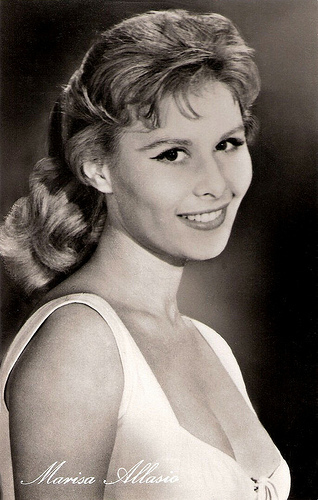
East-German postcard by VEB Progress Film-Vertrieb, Berlin, no. 1354, 1960. Retail price: 0,20 DM. Photo: Progress.
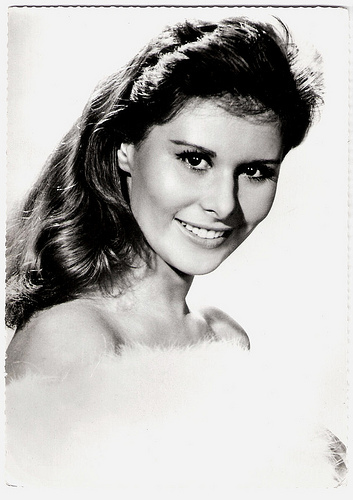
Yugoslavian postcard by 3K, no. 3918.
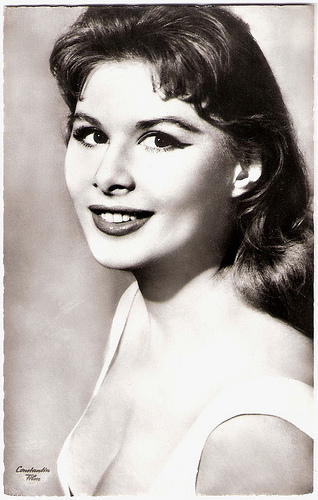
German postcard by Kolibri-Verlag G.m.b.H., Minden/Westf., no. 144. Photo: Titanus / Constantin.
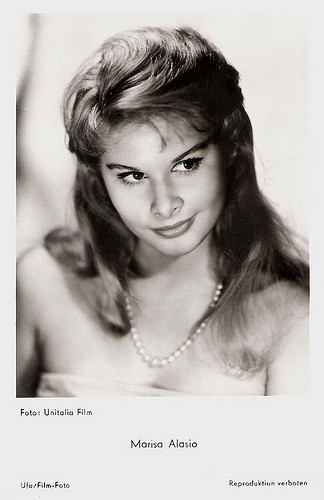
German postcard by Ufa, Berlin-Tempelhof, no. FK 4182. Photo: Unitalia Film.

German postcard by Universum-Film Aktiengesellschaft (Ufa), Berlin-Tempelhof, no. PK 3914. Retail price: 25 Pfg. Photo: G. Poletto / Ufa. (The name of the actress is misspelled on the postcard).
Sources: Glamour Girls of the Silver Screen, Wikipedia (Italian) and .

Italian postcard by Rotalcolor, no. 1.

Italian postcard by Rotalfoto, no. 714.

Italian postcard by Rotalfoto, no. R. 107.

Italian postcard by SA Poligrafica Sammarinese, no. 020-d.

German postcard by Universum-Film Aktiengesellschaft (UFA), Berlin-Tempelhof, no. CK-174. Retail price: 30 Pfg. Photo: G.B. Poletto / UFA.
Miss Lido
Marisa Allasio was born Maria Luisa Lucia Allasio in Turin in 1936. She was the daughter of Federico Allasio, road contractor, goalkeeper of the Torino soccer team ánd coach of many Italian soccer teams, and his wife Lucia Rocchietti.
At 14, she was crowned Miss Lido, winning her first and only beauty contest. When Italian magazines published pin-up art of 'Miss Lido,' she was transferred to a public school.
At 16, Marisa made her film debut in a bit part in the melodrama Perdonami!/Forgive me (Mario Costa, 1952) starring Raf Vallone and Antonella Lualdi. She talked her parents into enrolling her in Rome’s Academy of Dramatic Arts.
The following years she appeared in Italian film productions like the soccer film Gli eroi della domenica/The Sunday Heroes (Mario Camerini, 1953) starring Raf Vallone and Marcello Mastroianni, Cuore di mamma/Mother's Heart (Luigi Capuano, 1954), and Ragazze d'oggi/Girls of Today (Luigi Zampa, 1955).
She also had an uncredited part in the international epic War and Peace (King Vidor, 1956) based on the famous novel by Leo Tolstoy and starring Audrey Hepburn , Henry Fonda and Mel Ferrer.

Yugoslavian postcard.

Yugoslavian postcard by Studio Sombor, no. 213.

Yugoslavian postcard by Studio Sombor, no. 300.

Italian postcard. Publicity still for Ragazze d'oggi/Girls of Today (Luigi Zampa, 1955) with Mike Bongiorno .

With Maurizio Arena. East-German postcard by VEB Progress Film-Vertrieb, Berlin, no. 1355, 1960. Retail price: 0,20 DM. Photo: Progress.

East-German postcard by VEB Progress Film-Vertrieb, Berlin, no. 1356, 1961. Retail price: 0,20 DM. Photo: Progress. Publicity still for Poveri ma belli/Poor But Beautiful (Dino Risi, 1957) with Renato Salvatori and Maurizio Arena.
Bikini Girl
Marisa Allasio had her breakthrough as Giovanna in the comedy Poveri ma belli/Poor But Beautiful (Dino Risi, 1956) opposite Renato Salvatori and Maurizio Arena and the sequel Belle ma povere/Poor Girl, Pretty Girl (Dino Risi, 1957).
Her part wins her national notoriety when the Pope condemns posters advertising it as 'overly exciting.' The posters are seized by Italian police. Despite this scandal she became popular as ‘la ragazza bella’, with her amazing curves clad in a bikini.
She appeared as the main attraction in comedies like Marisa la civetta/Marisa (Mauro Bolognini, 1957) again with Renato Salvatori , Camping (Franco Zeffirelli, 1957), Susanna tutta panna/Susanna, you whipped cream (Steno, 1957), and Venezia, la luna e tu/Venice, the Moon and You (Dino Risi, 1958) with Alberto Sordi .
As a pin-up she became hugely popular. In 1957 she was on the cover of Modern Man Quarterly Fall 1957, and an international breakthrough seemed only a matter of time. She appeared in the German-Italian coproduction Nackt, wie Gott sie schuf/Naked Like God Created Her (Hans Schott-Schöbinger, 1958), and the American-Italian Mario Lanza vehicle Seven Hills of Rome (Roy Rowland, 1958). But that would be her final film.
In 1958 she married Conte Pierfrancesco Calvi. Her husband is the 7th count of Bèrgolo, Head of the Calvi di Bèrgolo Family, since 1977. His mother was a daughter of H.R.M. Vittorio Emanuele III, King of Italy, King of Albania and Emperor of Ethiopia, and H.R.H. Elena Petrovich-Njegosch, Princess of Montenegro. He was 27; she was 22. The private ceremony was attended by only two other persons. Both families were reported opposed to the marriage.
Today the count and his wife are still married and have two children, Carlo Georgio (1959), and Anda Federica a.k.a. Yolanda (1962). The Italian New Wave group Diaframma dedicated a song to her, called Marisa Allasio. It’s on their album 3 Volte Lacrime (1986).

East-German postcard by VEB Progress Film-Vertrieb, Berlin, no. 1354, 1960. Retail price: 0,20 DM. Photo: Progress.

Yugoslavian postcard by 3K, no. 3918.

German postcard by Kolibri-Verlag G.m.b.H., Minden/Westf., no. 144. Photo: Titanus / Constantin.

German postcard by Ufa, Berlin-Tempelhof, no. FK 4182. Photo: Unitalia Film.

German postcard by Universum-Film Aktiengesellschaft (Ufa), Berlin-Tempelhof, no. PK 3914. Retail price: 25 Pfg. Photo: G. Poletto / Ufa. (The name of the actress is misspelled on the postcard).
Sources: Glamour Girls of the Silver Screen, Wikipedia (Italian) and .
Published on December 09, 2015 22:00
December 8, 2015
Dunungen (1919)
The Swedish silent film Dunungen/In Quest of Happiness (Ivan Hedqvist, 1919) was based on a short story and play by Selma Lagerlöf. The stars were Renée Björling, Ivan Hedqvist himself and Ragnar Widestedt.

Swedish postcard by Nordisk Konst, Stockholm, no. 1091/1. Photo: publicity still for Dunungen/In Quest of Happiness (Ivan Hedqvist, 1919).

Swedish postcard by Nordisk Konst, Stockholm, no. 1091/?. Photo: publicity still for Dunungen/In Quest of Happiness (Ivan Hedqvist, 1919).The lady on the left is Jenny Tschernichin-Larsson, who plays Teodor's mother.
A pack of worthless shares
The story of Dunungen (Ivan Hedqvist, 1919) is set in the 19th century. Star of the film is pretty Swedish film and stage actress Renée Björling (1888-1975). She peaked in the Swedish silent cinema, but later she also played small parts in the films of Ingmar Bergman.
In Duningen, Björling plays the baker's daughter Anne-Marie Ehringer, called Dunungen. Ragnar Widestedt plays the mayor's son Mauritz Fristedt, who has deeply fallen in love with Dunungen.
The mayor applauds the engagement of his son when Mauritz in exchange promises to try to foist on Uncle Theodore (Ivan Hedqvist) a pack of worthless shares that the father wants to get rid of. It is to the rich old bachelor uncle Theodore Mauritz and Dunungen will go on their engagement trip.
Dunungen gets attached to old Uncle Theodore and when Mauritz brings out the worthless shares and proposes Theodore a purchase, Dunungen prevents the deal.
The film was Ivan Hedqvist's directorial debut and Renée Björling's film debut in a larger context. Weyler Hildebrand made a remake of Dunungen in 1941 with cinematographer Julius Jaenzon who also had filmed this version of 1919.

Swedish postcard by Nordisk Konst, Stockholm, no. 1091/10. Photo: publicity still for Dunungen/In Quest of Happiness (Ivan Hedqvist, 1919).

Swedish postcard by Nordisk Konst, Stockholm, no. 1091/12. Photo: publicity still for Dunungen/In Quest of Happiness (Ivan Hedqvist, 1919).
Source: Wikipedia (Swedish) and IMDb.

Swedish postcard by Nordisk Konst, Stockholm, no. 1091/1. Photo: publicity still for Dunungen/In Quest of Happiness (Ivan Hedqvist, 1919).

Swedish postcard by Nordisk Konst, Stockholm, no. 1091/?. Photo: publicity still for Dunungen/In Quest of Happiness (Ivan Hedqvist, 1919).The lady on the left is Jenny Tschernichin-Larsson, who plays Teodor's mother.
A pack of worthless shares
The story of Dunungen (Ivan Hedqvist, 1919) is set in the 19th century. Star of the film is pretty Swedish film and stage actress Renée Björling (1888-1975). She peaked in the Swedish silent cinema, but later she also played small parts in the films of Ingmar Bergman.
In Duningen, Björling plays the baker's daughter Anne-Marie Ehringer, called Dunungen. Ragnar Widestedt plays the mayor's son Mauritz Fristedt, who has deeply fallen in love with Dunungen.
The mayor applauds the engagement of his son when Mauritz in exchange promises to try to foist on Uncle Theodore (Ivan Hedqvist) a pack of worthless shares that the father wants to get rid of. It is to the rich old bachelor uncle Theodore Mauritz and Dunungen will go on their engagement trip.
Dunungen gets attached to old Uncle Theodore and when Mauritz brings out the worthless shares and proposes Theodore a purchase, Dunungen prevents the deal.
The film was Ivan Hedqvist's directorial debut and Renée Björling's film debut in a larger context. Weyler Hildebrand made a remake of Dunungen in 1941 with cinematographer Julius Jaenzon who also had filmed this version of 1919.

Swedish postcard by Nordisk Konst, Stockholm, no. 1091/10. Photo: publicity still for Dunungen/In Quest of Happiness (Ivan Hedqvist, 1919).

Swedish postcard by Nordisk Konst, Stockholm, no. 1091/12. Photo: publicity still for Dunungen/In Quest of Happiness (Ivan Hedqvist, 1919).
Source: Wikipedia (Swedish) and IMDb.
Published on December 08, 2015 22:00
December 7, 2015
Dirk Bogarde
Sir Dirk Bogarde (1921-1999) was Britain's number one box office draw of the 1950s, gaining the title of ‘The Matinee Idol of the Odeon’. In the 1960s, he abandoned his heart-throb image for more challenging parts in films by Joseph Losey, John Schlesinger, Luchino Visconti, Liliane Cavani and Rainer Werner Fassbinder. Bogarde made a total of 63 films between 1939 and 1991.
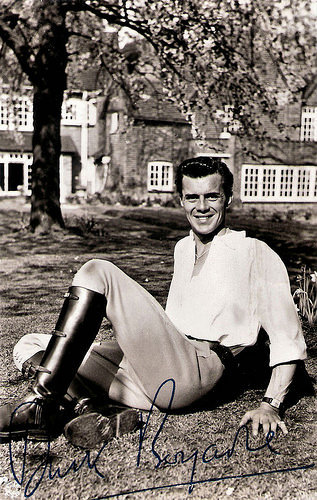
British autograph card. Photo: J. Arthur Rank Organisation.
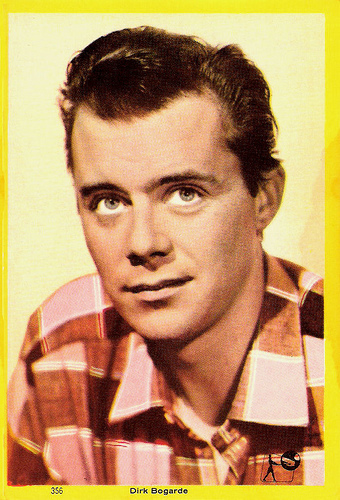
Mexican card, no. 356. Photo: Rank.

British Greetings card, no. E. Photo: J. Arthur Rank Organisation.
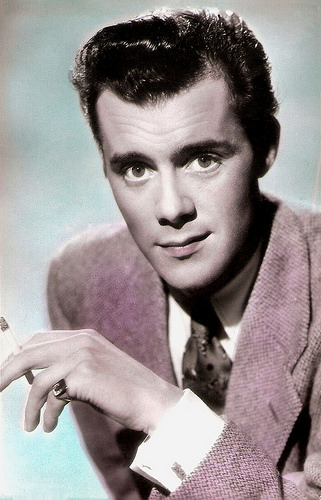
Yugoslavian postcard by Jugoturist, Beograd / Studio Sombor, no. 191.
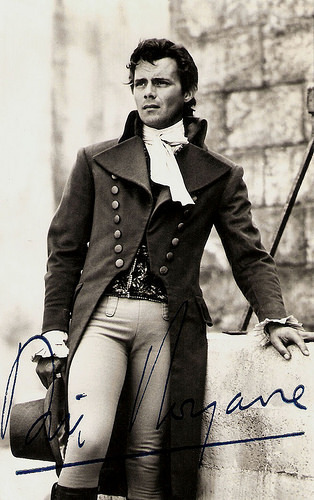
British postcard. Photo: Rank. Publicity still for A Tale of Two Cities (Ralph Thomas, 1958).
A dark and violent sexuality
Dirk Bogarde was born Derek Jules Gaspard Ulric Niven van den Bogaerde in London in 1921. He was of mixed Flemish, Dutch and Scottish ancestry. His father, Ulric van den Bogaerde was the art editor of London newspaper The Times and his mother Margaret Niven was a former actress. He attended the former Allan Glen's School in Glasgow and London's University College School, before majoring in commercial art at Chelsea Polytechnic.
Derek dropped out of his commercial art course and became a drama student, though his acting talent at that time was unpromising. In the late 1930s he went to work as a commercial artist and a scene designer. His London West End acting debut was in 1939 as Derek Bogaerde in J. B. Priestley's play Cornelius. That same year he appeared as an extra in the George Formby film Come on George! (Anthony Kimmins, 1939).
In 1940, nineteen-years old Derek joined the Queen’s Royal Regiment and served as an officer with the Air Photographic Intelligence Unit, where he eventually attained the rank of major and during his five years of active service was honoured on seven occasions. After the war his agent renamed him Dirk Bogarde, and in 1947 he appeared in Power Without Glory at the New Lindsay Theatre, a performance that was praised by Noel Coward, who urged him to continue his acting career.
His good looks helped him begin a career as a film actor. After several films for Gainsborough, none of them making much impact, his first lead came when Wessex Films gave him a part in the proposed Stewart Granger film Esther Waters (Ian Dalrymple, Peter Proud, 1948). When Granger dropped out, Bogarde took over the lead.
Rank subsequently signed him to a long-term contract and he appeared in a variety of parts during the 14 years he was under contract to this studio. He came to prominence playing the charismatic young hoodlum who shoots and kills a police constable in Ealing's The Blue Lamp (Basil Dearden, 1949). Bogarde brought a dark and violent sexuality to the role that came near to unbalancing the film's sober intentions. It was the first of the intense neurotics and attractive villains that Bogarde would often play, such as the murderer, who befriends a young boy, he played in Hunted (Charles Crichton, 1952).
His role as a medical student in Doctor in the House (Ralph Thomas, 1954) made Bogarde one of the most popular British stars of the 1950s. A staggering 17 million people saw the film in its first year. The next years he reprised his role in Doctor at Sea (Ralph Thomas, 1955) co-starring Brigitte Bardot, and Doctor at Large (Ralph Thomas, 1957) co-starring the later Bond girl Shirley Eaton .
He played a neurotic criminal opposite Alexis Smith in The Sleeping Tiger (1954), Bogarde's first film for American expatriate director Joseph Losey. In Cast a Dark Shadow (Lewis Gilbert, 1955), he was a man who marries women for money and then murders them. Other interesting films were The Spanish Gardener (Philip Leacock, 1956); A Tale of Two Cities (Ralph Thomas, 1958), a faithful retelling of Charles Dickens' classic; The Doctor's Dilemma (Anthony Asquith, 1959), based on a play by George Bernard Shaw; and Libel (Anthony Asquith, 1959), in which he played two separate roles opposite Olivia de Havilland.
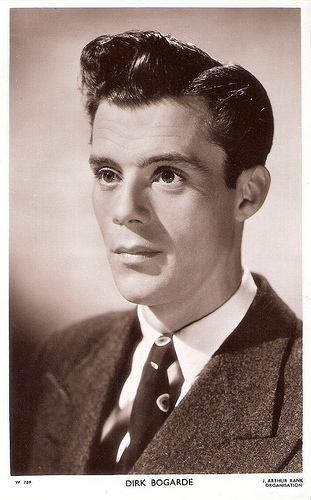
British postcard by Picturegoer Series, London, no. W. 789. Photo: J. Arthur Rank Organisation.
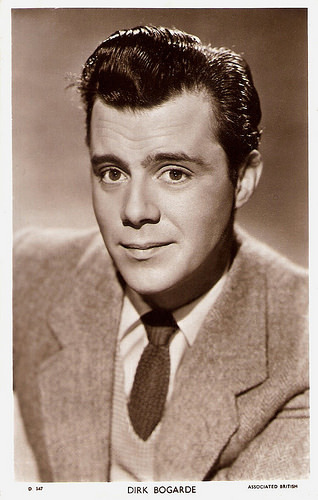
British postcard in the Picturegoer Series, London, no. D 547. Photo: Associated British.
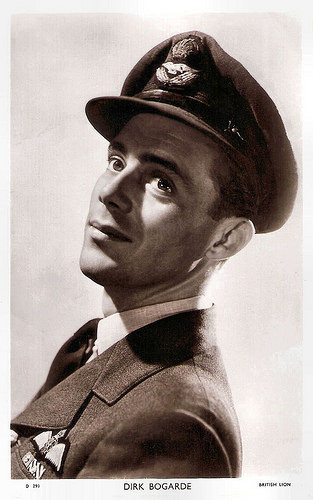
British postcard in the Picturegoer Series, London, no. D 290. Photo: British Lion.
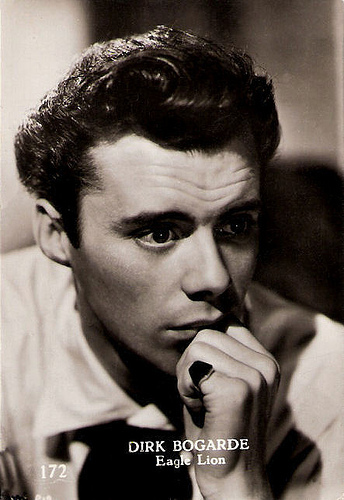
Vintage minicard, no. 172. Photo: Eagle Lion.
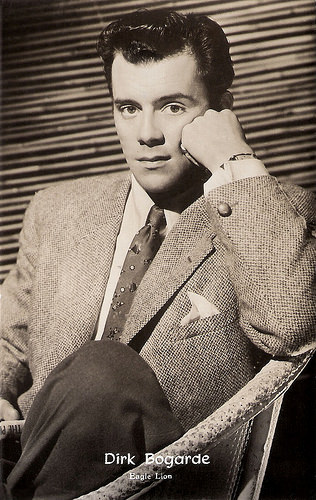
British card. Photo: Eagle Lion.
Victim
After leaving the Rank Organisation, Dirk Bogarde went to Hollywood. There he played Hungarian composer and virtuoso pianist Franz Liszt in Song Without End (Charles Vidor, George Cukor, 1960), and an unfrocked priest who falls in love with cabaret entertainer Ava Gardner during the Spanish Civil War in The Angel Wore Red (Nunnally Johnson, 1960). Both were big-budgeted films, but hampered by poor scripts, and neither fared well. Bogarde decided to avoid Hollywood productions in the future.
He abandoned his heart-throb image for more challenging parts. First he starred in the landmark film Victim (Basil Dearden, 1961). He played Melville Farr, a prominent and secretly homosexual lawyer who fights the blackmailers of a young man with whom he had a relationship. The young man commits suicide after being arrested for embezzlement, rather than to ruin the attorney's reputation. In the process of exposing the ring of extortionists, Bogarde's character puts at risk his successful legal career and marriage in order to see that justice is served.
Victim was the first mainstream British film to treat the subject of homosexuality seriously and the film helped lead to a change in English law decriminalising homosexuality. Acting in Victim was a very brave move of Bogarde in the years before the decriminalisation of male homosexuality with the 1967 Sexual Offences Act.
Privately he had a long-term relationship with his manager, Anthony Forwood since 1939. Forwood was a former husband of the actress Glynis Johns and the father of her only child, actor Gareth Forwood. They lived together, first in Amersham, England, then in France. According to Wikipedia , Bogarde's refusal to enter into a marriage of convenience in order to cover up his homosexuality was probably a major reason for his failure to become a star in Hollywood, together with the critical and commercial failure of Song Without End.
In Europe he played classic roles in more complex, art house films such as the decadent valet Hugo Barrett in The Servant (Joseph Losey, 1963) written by Harold Pinter; television reporter Robert Gold in Darling (John Schlesinger, 1965) starring Julie Christie ; Stephen, a bored Oxford University professor in Accident (Joseph Losey, 1967) also written by Pinter; German industrialist Frederick Bruckman in La caduta degli dei/The Damned (Luchino Visconti, 1969); the Nazi ex-concentration camp guard obsessed with one of his previous inmates ( Charlotte Rampling ) in the chilling and highly controversial Il portiere di notte/The Night Porter (Liliana Cavani, 1974), and, most notably, in Morte a Venezia/Death in Venice (Luchino Visconti, 1971) as Gustav von Aschenbach, a dying composer obsessed with a beautiful boy in a city ravaged by cholera.
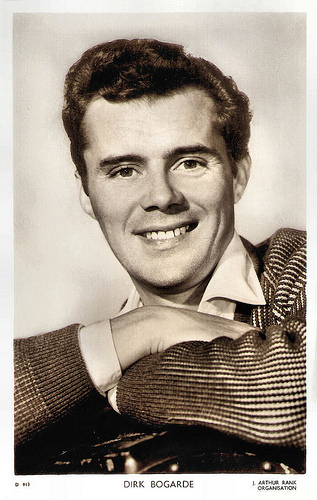
British postcard in the Picturegoer Series, London, no. D 913. Photo: J. Arthur Rank Organisation.
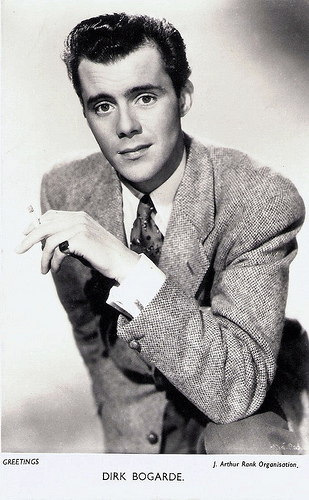
British postcard. Photo: J. Arthur Rank Organisation.
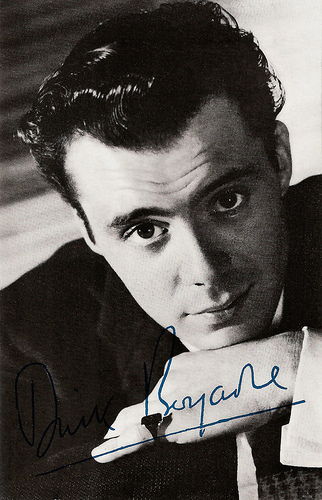
British postcard in the Film Star Autograph Portrait Series by Celebrity Publishers, London, no. 51. Photo: Cornel Lucas / Rank.
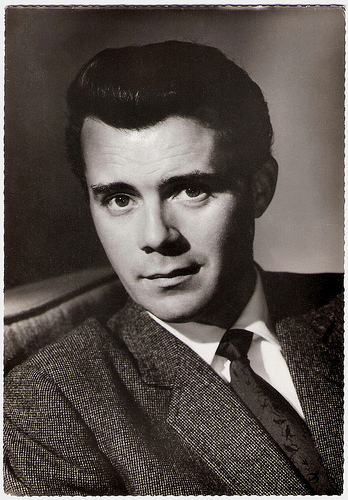
Yugoslavian postcard by ZK, no. 4236. Photo: Rank.
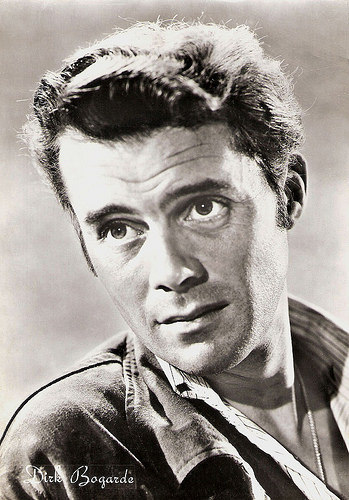
Italian postcard by Rotalfoto, Milano, no. 863.
Second Career
During the 1960s and 1970s, Dirk Bogarde played opposite renowned stars, yet several of the films were of uneven quality. In the campy The Singer Not the Song (Roy Ward Baker, 1961), he was a Mexican bandit co-starring with John Mills as a priest. In H.M.S. Defiant (Lewis Gilbert, 1962), he played sadistic Lieutenant Scott-Padget opposite Sir Alec Guinness . In I Could Go On Singing (Ronald Neame, 1963), he co-starred with Judy Garland in her final screen role.
In King & Country (Joseph Losey, 1964) he played an army lawyer reluctantly defending deserter Tom Courtenay. Losey's Modesty Blaise (Joseph Losey, 1966) was a campy spy send-up in which he co-starred as archvillain Gabriel opposite Monica Vitti and Terence Stamp . Our Mother's House (Jack Clayton, 1967) was an off-beat film in which he played an estranged father of seven children. In The Fixer (John Frankenheimer, 1968), based on Bernard Malamud's novel, he co-starred with Alan Bates ; in Oh! What a Lovely War (Richard Attenborough, 1969), his co-stars were Sir John Gielgud and Sir Laurence Olivier , and in Le Serpent/The Serpent (Henri Verneuil, 1973) he appeared with Henry Fonda and Yul Brynner.
In 1977, Bogarde embarked on his second career as an author. Starting with a first volume A Postillion Struck by Lightning (1977), he wrote a series of autobiographical volumes, novels and book reviews. While in his autobiographical works Bogarde carefully avoids direct discussion of homosexuality, he does discuss his relationship with his partner, particularly his care of him during the latter's long terminal illness. According to Wikipedia, the writer Bogarde displayed a witty, elegant, highly literate and thoughtful style.
Among his later films were the art house hit Providence (Alain Resnais, 1977) co-starring Sir John Gielgud ; the all-star blockbuster A Bridge Too Far (Richard Attenborough, 1977), and the Vladimir Nabokov adaptation Despair (Rainer Werner Fassbinder, 1978). His final film role was in Daddy Nostalgie/These Foolish Things (Bertrand Tavernier, 1991) co-starring Jane Birkin as his daughter. Bogarde's controversial film choices later in his career led him to have something of a cult following.
Formerly a heavy smoker, Bogarde suffered a minor stroke in November 1987 while Anthony Forwood was dying of liver cancer and Parkinson's disease. Never afraid of voicing his opinion, after witnessing Forwood's protracted death he became active in promoting voluntary euthanasia for terminally ill patients in Britain and toured the UK giving lectures and answering questions from live audiences on the subject.
Dirk Bogarde died in London from a heart attack in 1999, aged 78. He was nominated six times as Best Actor by the British Academy of Film and Television Arts (BAFTA), winning twice, for The Servant in 1963, and for Darling in 1965. He also received the London Film Critics Circle Lifetime Award in 1991. He was knighted in 1992 for services to acting, and was the recipient of honorary doctorates from several universities including St Andrews and Sussex. In the Encyclopedia of British Cinema , Brian McFarlane writes about Bogarde: "he was the British film actor and star par excellence, sometimes making bricks out of straw but also making impressive houses out of bricks."
Trailer for Victim (1961). Source: Night Of The Trailers (YouTube).
Trailer Doctor In Distress (1963). Source: Trailers Galore! (YouTube).
Trailer for The Servant (1963). Source: Carlos ESNAOLA (YouTube).
Trailer for Darling (1965). Source: Classic British film (YouTube).
Trailer for Morte a Venezia/Death in Venice (1971). Source: Movieclips Trailer Vault (YouTube).
Sources: (IMDb), Brian McFarlane (Encyclopedia of British Cinema), Patricia Juliana Smith (glbtq), David Absalom (British Pictures), Clive Saunders (BritMovie), Wikipedia, and .

British autograph card. Photo: J. Arthur Rank Organisation.

Mexican card, no. 356. Photo: Rank.

British Greetings card, no. E. Photo: J. Arthur Rank Organisation.

Yugoslavian postcard by Jugoturist, Beograd / Studio Sombor, no. 191.

British postcard. Photo: Rank. Publicity still for A Tale of Two Cities (Ralph Thomas, 1958).
A dark and violent sexuality
Dirk Bogarde was born Derek Jules Gaspard Ulric Niven van den Bogaerde in London in 1921. He was of mixed Flemish, Dutch and Scottish ancestry. His father, Ulric van den Bogaerde was the art editor of London newspaper The Times and his mother Margaret Niven was a former actress. He attended the former Allan Glen's School in Glasgow and London's University College School, before majoring in commercial art at Chelsea Polytechnic.
Derek dropped out of his commercial art course and became a drama student, though his acting talent at that time was unpromising. In the late 1930s he went to work as a commercial artist and a scene designer. His London West End acting debut was in 1939 as Derek Bogaerde in J. B. Priestley's play Cornelius. That same year he appeared as an extra in the George Formby film Come on George! (Anthony Kimmins, 1939).
In 1940, nineteen-years old Derek joined the Queen’s Royal Regiment and served as an officer with the Air Photographic Intelligence Unit, where he eventually attained the rank of major and during his five years of active service was honoured on seven occasions. After the war his agent renamed him Dirk Bogarde, and in 1947 he appeared in Power Without Glory at the New Lindsay Theatre, a performance that was praised by Noel Coward, who urged him to continue his acting career.
His good looks helped him begin a career as a film actor. After several films for Gainsborough, none of them making much impact, his first lead came when Wessex Films gave him a part in the proposed Stewart Granger film Esther Waters (Ian Dalrymple, Peter Proud, 1948). When Granger dropped out, Bogarde took over the lead.
Rank subsequently signed him to a long-term contract and he appeared in a variety of parts during the 14 years he was under contract to this studio. He came to prominence playing the charismatic young hoodlum who shoots and kills a police constable in Ealing's The Blue Lamp (Basil Dearden, 1949). Bogarde brought a dark and violent sexuality to the role that came near to unbalancing the film's sober intentions. It was the first of the intense neurotics and attractive villains that Bogarde would often play, such as the murderer, who befriends a young boy, he played in Hunted (Charles Crichton, 1952).
His role as a medical student in Doctor in the House (Ralph Thomas, 1954) made Bogarde one of the most popular British stars of the 1950s. A staggering 17 million people saw the film in its first year. The next years he reprised his role in Doctor at Sea (Ralph Thomas, 1955) co-starring Brigitte Bardot, and Doctor at Large (Ralph Thomas, 1957) co-starring the later Bond girl Shirley Eaton .
He played a neurotic criminal opposite Alexis Smith in The Sleeping Tiger (1954), Bogarde's first film for American expatriate director Joseph Losey. In Cast a Dark Shadow (Lewis Gilbert, 1955), he was a man who marries women for money and then murders them. Other interesting films were The Spanish Gardener (Philip Leacock, 1956); A Tale of Two Cities (Ralph Thomas, 1958), a faithful retelling of Charles Dickens' classic; The Doctor's Dilemma (Anthony Asquith, 1959), based on a play by George Bernard Shaw; and Libel (Anthony Asquith, 1959), in which he played two separate roles opposite Olivia de Havilland.

British postcard by Picturegoer Series, London, no. W. 789. Photo: J. Arthur Rank Organisation.

British postcard in the Picturegoer Series, London, no. D 547. Photo: Associated British.

British postcard in the Picturegoer Series, London, no. D 290. Photo: British Lion.

Vintage minicard, no. 172. Photo: Eagle Lion.

British card. Photo: Eagle Lion.
Victim
After leaving the Rank Organisation, Dirk Bogarde went to Hollywood. There he played Hungarian composer and virtuoso pianist Franz Liszt in Song Without End (Charles Vidor, George Cukor, 1960), and an unfrocked priest who falls in love with cabaret entertainer Ava Gardner during the Spanish Civil War in The Angel Wore Red (Nunnally Johnson, 1960). Both were big-budgeted films, but hampered by poor scripts, and neither fared well. Bogarde decided to avoid Hollywood productions in the future.
He abandoned his heart-throb image for more challenging parts. First he starred in the landmark film Victim (Basil Dearden, 1961). He played Melville Farr, a prominent and secretly homosexual lawyer who fights the blackmailers of a young man with whom he had a relationship. The young man commits suicide after being arrested for embezzlement, rather than to ruin the attorney's reputation. In the process of exposing the ring of extortionists, Bogarde's character puts at risk his successful legal career and marriage in order to see that justice is served.
Victim was the first mainstream British film to treat the subject of homosexuality seriously and the film helped lead to a change in English law decriminalising homosexuality. Acting in Victim was a very brave move of Bogarde in the years before the decriminalisation of male homosexuality with the 1967 Sexual Offences Act.
Privately he had a long-term relationship with his manager, Anthony Forwood since 1939. Forwood was a former husband of the actress Glynis Johns and the father of her only child, actor Gareth Forwood. They lived together, first in Amersham, England, then in France. According to Wikipedia , Bogarde's refusal to enter into a marriage of convenience in order to cover up his homosexuality was probably a major reason for his failure to become a star in Hollywood, together with the critical and commercial failure of Song Without End.
In Europe he played classic roles in more complex, art house films such as the decadent valet Hugo Barrett in The Servant (Joseph Losey, 1963) written by Harold Pinter; television reporter Robert Gold in Darling (John Schlesinger, 1965) starring Julie Christie ; Stephen, a bored Oxford University professor in Accident (Joseph Losey, 1967) also written by Pinter; German industrialist Frederick Bruckman in La caduta degli dei/The Damned (Luchino Visconti, 1969); the Nazi ex-concentration camp guard obsessed with one of his previous inmates ( Charlotte Rampling ) in the chilling and highly controversial Il portiere di notte/The Night Porter (Liliana Cavani, 1974), and, most notably, in Morte a Venezia/Death in Venice (Luchino Visconti, 1971) as Gustav von Aschenbach, a dying composer obsessed with a beautiful boy in a city ravaged by cholera.

British postcard in the Picturegoer Series, London, no. D 913. Photo: J. Arthur Rank Organisation.

British postcard. Photo: J. Arthur Rank Organisation.

British postcard in the Film Star Autograph Portrait Series by Celebrity Publishers, London, no. 51. Photo: Cornel Lucas / Rank.

Yugoslavian postcard by ZK, no. 4236. Photo: Rank.

Italian postcard by Rotalfoto, Milano, no. 863.
Second Career
During the 1960s and 1970s, Dirk Bogarde played opposite renowned stars, yet several of the films were of uneven quality. In the campy The Singer Not the Song (Roy Ward Baker, 1961), he was a Mexican bandit co-starring with John Mills as a priest. In H.M.S. Defiant (Lewis Gilbert, 1962), he played sadistic Lieutenant Scott-Padget opposite Sir Alec Guinness . In I Could Go On Singing (Ronald Neame, 1963), he co-starred with Judy Garland in her final screen role.
In King & Country (Joseph Losey, 1964) he played an army lawyer reluctantly defending deserter Tom Courtenay. Losey's Modesty Blaise (Joseph Losey, 1966) was a campy spy send-up in which he co-starred as archvillain Gabriel opposite Monica Vitti and Terence Stamp . Our Mother's House (Jack Clayton, 1967) was an off-beat film in which he played an estranged father of seven children. In The Fixer (John Frankenheimer, 1968), based on Bernard Malamud's novel, he co-starred with Alan Bates ; in Oh! What a Lovely War (Richard Attenborough, 1969), his co-stars were Sir John Gielgud and Sir Laurence Olivier , and in Le Serpent/The Serpent (Henri Verneuil, 1973) he appeared with Henry Fonda and Yul Brynner.
In 1977, Bogarde embarked on his second career as an author. Starting with a first volume A Postillion Struck by Lightning (1977), he wrote a series of autobiographical volumes, novels and book reviews. While in his autobiographical works Bogarde carefully avoids direct discussion of homosexuality, he does discuss his relationship with his partner, particularly his care of him during the latter's long terminal illness. According to Wikipedia, the writer Bogarde displayed a witty, elegant, highly literate and thoughtful style.
Among his later films were the art house hit Providence (Alain Resnais, 1977) co-starring Sir John Gielgud ; the all-star blockbuster A Bridge Too Far (Richard Attenborough, 1977), and the Vladimir Nabokov adaptation Despair (Rainer Werner Fassbinder, 1978). His final film role was in Daddy Nostalgie/These Foolish Things (Bertrand Tavernier, 1991) co-starring Jane Birkin as his daughter. Bogarde's controversial film choices later in his career led him to have something of a cult following.
Formerly a heavy smoker, Bogarde suffered a minor stroke in November 1987 while Anthony Forwood was dying of liver cancer and Parkinson's disease. Never afraid of voicing his opinion, after witnessing Forwood's protracted death he became active in promoting voluntary euthanasia for terminally ill patients in Britain and toured the UK giving lectures and answering questions from live audiences on the subject.
Dirk Bogarde died in London from a heart attack in 1999, aged 78. He was nominated six times as Best Actor by the British Academy of Film and Television Arts (BAFTA), winning twice, for The Servant in 1963, and for Darling in 1965. He also received the London Film Critics Circle Lifetime Award in 1991. He was knighted in 1992 for services to acting, and was the recipient of honorary doctorates from several universities including St Andrews and Sussex. In the Encyclopedia of British Cinema , Brian McFarlane writes about Bogarde: "he was the British film actor and star par excellence, sometimes making bricks out of straw but also making impressive houses out of bricks."
Trailer for Victim (1961). Source: Night Of The Trailers (YouTube).
Trailer Doctor In Distress (1963). Source: Trailers Galore! (YouTube).
Trailer for The Servant (1963). Source: Carlos ESNAOLA (YouTube).
Trailer for Darling (1965). Source: Classic British film (YouTube).
Trailer for Morte a Venezia/Death in Venice (1971). Source: Movieclips Trailer Vault (YouTube).
Sources: (IMDb), Brian McFarlane (Encyclopedia of British Cinema), Patricia Juliana Smith (glbtq), David Absalom (British Pictures), Clive Saunders (BritMovie), Wikipedia, and .
Published on December 07, 2015 22:00
December 6, 2015
Renée Sylvaire
In the early 1910s, French actress Renée Sylvaire was one of the regular actresses of the company Éclair. She played in over 60 silent films between 1909 and 1923.
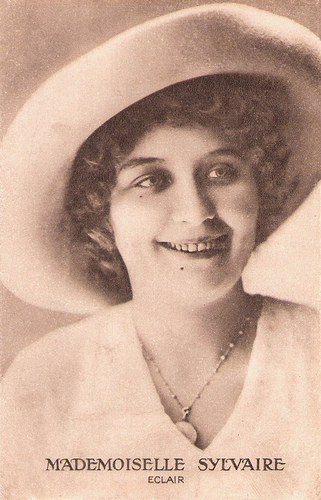
French postcard. Photo: Eclair.
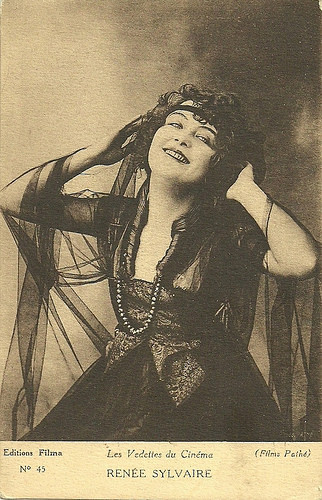
French postcard in Les Vedettes du Cinéma Series by Editions Filma, no. 45. Photo: Films Pathé.
American Scandal
When Renée Sylvaire was born is unknown. She began her career when onereelers still ruled in film. Her first known film role was in Rédemption/John Farley's Redemption (Victorin-Hippolyte Jasset, 1909), where she played opposite Charles Krauss, one of the regulars of the Éclair company.
The plot of this film is not far afield from the scandal of American star Evelyn Nesbit's real life, in which her husband murdered famed architect Stanford White in retaliation for his presumed affair with Nesbit.
After this debut it took some time before Sylvaire could continue at Éclair, as in 1910 the company focused on classic plays with mainly acclaimed stage actors.
Instead she played at Pathé in such short films as Une petite femme bien douce/A Sweet Little French Lady (Georges Denola, 1910) with Mistinguett , and Philémon et Baucis (Georges Denola, 1911) with Romuald Joubé .
In 1911, she returned to Éclair to play in such shorts as La fleur des neiges/The Snow Flower (1911), and Le grand-pere/The Grandfather (1911), and her first feature film La dame de chez Maxim's/Girl from Maxim's (1912), an adaptation of the Georges Feydeau comedy. All these films were made under the solid direction of Emile Chautard. The script for La dame de chez Maxim's was written by Maurice Tourneur, who would later direct her in several films.
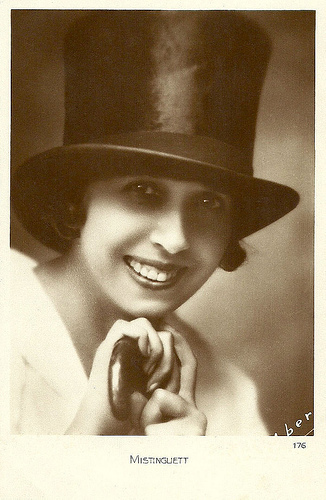
Mistinguett French postcard, no. 176. Collection: Didier Hanson.
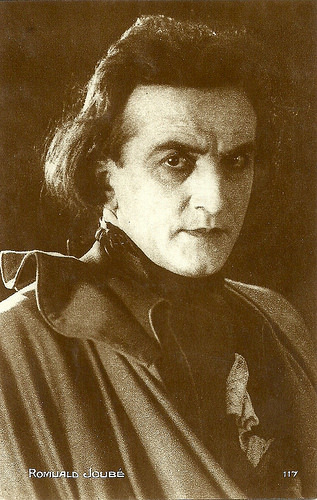
Romuald Joubé . French postcard by Editions Cinémagazine, no. 117.
The enormously productive year 1913
1913 was an enormously productive year for Renée Sylvaire. She played in the onereeler La malédiction/The Curse (Emile Chautard, 1913), and the two-reelers Le chemin du coeur/The Way of the Heart (1913) with Charles Krauss, L’assaut de la terre/The Assault of the Earth, Le trésor des Baux/Baux's Treasure, Sacrifice, two episodes of the serial Destin tragique/Tragic Destiny, La maison du glacier/The House of the Ice-cream Maker (all directed by Victorin-Hippolyte Jasset in 1913), La bergère d’Ivry (Maurice Tourneur, known to be his earliest surviving film, 1913) about the plight of an orphan girl, and the horrifying Le système du docteur Gourdon et du professeur Plume/The Lunatics (Maurice Tourneur, 1913), adapted from a one-act Grand Guignol play based on Edgar Allen Poe’s short story The System of Dr. Tarr and professor Fether.
Sylvaire played the female lead in the threereelers Mathilde (Emile Chautard, 1913) after the novel by Eugène Sue, La gueuse (unknown director, 1913), and Le chiffonier de Paris/The Ragman of Paris (Emile Chautard, 1913). She also had major roles in the threereelers La justicière/The Female Leader (Gérard Bourgeois, Victorin-Hippolyte Jasset, 1913) opposite Josette Andriot, and Le coeur d’une gosse/The heart of a Street Urchin, (Emile Chautard, 1913).
Sylvaire also played in the four-reelers Jack (André Liabel, 1913), an adaptation of Alphonse Daudet’s novel featuring Villeneuve, and La fiancée maudite/The Accursed Fiancé (Emile Chautard, 1913) with Josette Andriot. Finally Sylvaire also played in two films of which the length is unknown, Val d'enfer/Hell Valley (Victorin-Hippolyte Jasset, 1913) and in another Feydeau adaptation La duchesse des Folies-Bergères/The Duchess of the Folies-Bergères (Emil Chautard, 1913, ).
Next to the above mentioned titles from the Éclair filmography published in 1992, IMDb lists five other short 1913 films with Sylvaire. These are Trompe-la-Mort/Mistaken Death (Charles Krauss, 1913) based on a novel by Honoré de Balzac, Soeurette (Maurice Tourneur, 1913) with Pauline Polaire, Les ruses de l'amour/The Tricks of Love (Maurice Tourneur, 1913), L’auberge sanglante/The Inn of Blood (Emile Chautard, 1913), and La nièce d’Amérique/The American Niece (Gérard Bourgeois, 1913). Harry Waldman’s study of Maurice Tourneur also mentions Le dernier pardon (Maurice Tourneur, 1913). A total of 23 (short) films - all done in 1913!
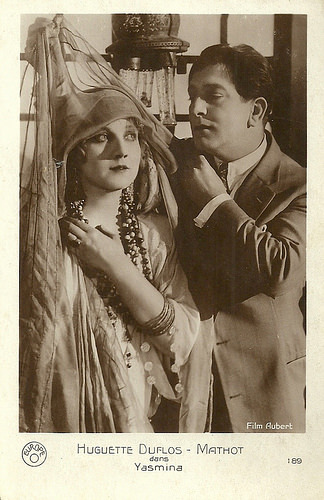
Huguette Duflos . French postcard by Europe, no. 189. Photo: Film Aubert. Publicity still of Huguette Duflos and Léon Mathot in Yasmina (André Hugon, 1927).
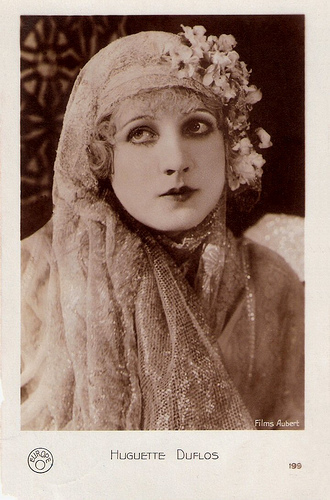
French postcard by Europe, no. 199. Photo: Films Aubert.
Grand Guignol
In 1914, Renée Sylvaire continued her fruitful and busy career at Éclair. She alternated major or minor film roles with leading roles. She was the female star of the two-reeler comedy Mademoiselle Josette, ma femme/Miss Josette, My Wife (André Liabel, 1914) and of the threereeler drama Le corso rouge/The Red Procession (Charles Krauss, Maurice Tourneur, 1914). She could also be seen a.o. in the fourreeler (feature-length) comedy set in a circus milieu Le friquet (Maurice Tourneur, 1914), starring Pauline Polaire; the threereeler Le puits mitoyen/The Secret of the Well (Maurice Tourneur, 1914) with Henry Roussel; and the tworeeler comedy L’idée de Françoise/Francis' Idea (Emil Chautard, 1914).
Figures de cire/Wax Figures (Maurice Tourneur, 1914) was another Grand Guignol-story based on Le système du docteur Gourdon et du professeur Plume. It was the forerunner of Paul Leni’s classic Waxworks/Wachsfigurenkabinett (1924). In May 1914, Maurice Tourneur left for the US to work at the Éclair studio’s in Fort Lee, thus robbing Sylvaire of an innovative director. When the First World War broke out and production at Éclair was reduced to mostly short comedies and non-fiction, Sylvaire also played less roles.
In 1915 she only played in the third sequel of the Protéa adventure serial: La course à la mort/The Death Race (Joseph Faivre, supervised by Gérard Bourgeois, 1915) with Josette Andriot and the future director Jacques Feyder. In 1916 followed only the threereeler Un coup de feu dans la nuit/A Shot in the Night (Gérard Bourgeois, 1916). Then she appeared in Le mort invisible/The Invisible Death (Adolphe Candé, 1917), the fourth part of the Protéa series: Les mystères du Chateau Malmort/The Mysteries of the Castle of Malmort (Gérard Bourgeois, 1917), and L’âpre lutte/The Fierce Struggle (Jacques de Féraudy, Robert Boudrioz, 1917).
Sylvaire had been an actress at the Theatre du Renaissance, but was now engaged at the Theatre du Grand Guignol. In 1918 Sylvaire still played in one more film by Éclair La distance/The Distance (Robert Boudrio, 1918). Then she left Éclair as the company was falling apart. When the fifth Protéa sequel came out in early 1919, the last film released by Éclair, Josette Andriot had another co-star. In 1918 Sylvaire played for Pathé in La route du devoir/The Journey of Duty (Georges Monca, 1918) with Charles Prince , and Le boudoir japonais/The Japanese Boudoir (Georges Monca, 1918) and had a lead in Le fils naturel/The Natural Son (Jacques de Baroncelli, 1918), after Alexandre Dumas fils.
The following year she played in L’impasse Messidor/The Messidor Cul-de-sac (Camille de Morlhon, 1919), Le sang des immortelles/The Blood of the Immortals (André Liabel, 1919), and La gloire douloureuse/The Painful Glory (Maurice Landais, 1919). The next years Sylvaire played the lead in Les femmes des autres/Other Men's Wifes (Pierre Marodon, 1920), Des fleurs sur la mer/Flowers on the Sea (André Liabel, 1922) and Etre ou ne pas être/To Be or Not To Be (René Leprince, 1922) with Léon Mathot.
In 1923 she still had substantial roles in Le château des fantômes/The Haunted Castle (Pierre Marodon, 1923), and L'ile sans amour/The Island Without Love (Jean Legrand, 1923). Her last known role was a small part in the spectacular production Koenigsmark/The Secret Spring (Léonce Perret, 1923). This film featured a whole new generation of film stars: Huguette Duflos, Jaque Catelain , Iván Petrovich , etc.
The film career of Renée Sylvaire halted here and there is no information about her later life. About her stage career is not much known either. Happily several films with Renée Sylvaire have shown up over the last decades. In the Desmet Collection of the Eye Film Institute were found a.o. Le coeur et les yeux, Amours et science, and La bergère d’Ivry. A few years ago also Maurice Tourneur’s Le friquet showed up and has been restored since.
Whoever has more information about Renée Sylvaire, please mail us.
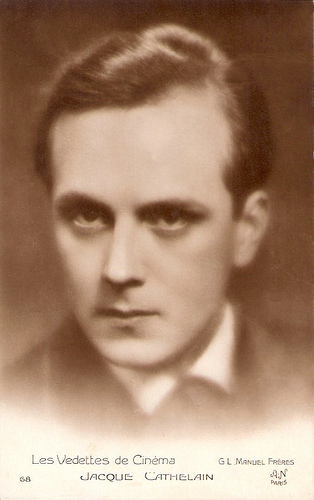
Jaque Catelain . French postcard by A.N., Paris. in the Les vedettes de Cinema series, no. 68. Photo: G.L. Manuel Frères.
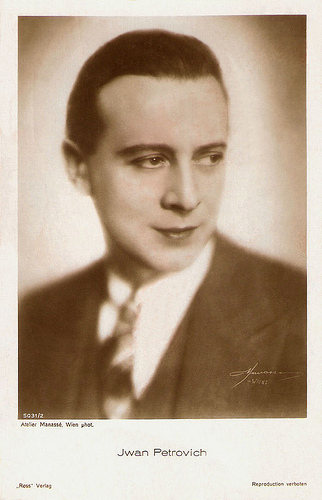
Iván Petrovich . German postcard by Ross Verlag, no. 5031/2, 1930-1931. Photo: Atelier Manassé, Wien.
Sources: Filmography Éclair (Griffithiana 44/45, 1992); Harry Waldman (Maurice Tourneur. The life and films), and .

French postcard. Photo: Eclair.

French postcard in Les Vedettes du Cinéma Series by Editions Filma, no. 45. Photo: Films Pathé.
American Scandal
When Renée Sylvaire was born is unknown. She began her career when onereelers still ruled in film. Her first known film role was in Rédemption/John Farley's Redemption (Victorin-Hippolyte Jasset, 1909), where she played opposite Charles Krauss, one of the regulars of the Éclair company.
The plot of this film is not far afield from the scandal of American star Evelyn Nesbit's real life, in which her husband murdered famed architect Stanford White in retaliation for his presumed affair with Nesbit.
After this debut it took some time before Sylvaire could continue at Éclair, as in 1910 the company focused on classic plays with mainly acclaimed stage actors.
Instead she played at Pathé in such short films as Une petite femme bien douce/A Sweet Little French Lady (Georges Denola, 1910) with Mistinguett , and Philémon et Baucis (Georges Denola, 1911) with Romuald Joubé .
In 1911, she returned to Éclair to play in such shorts as La fleur des neiges/The Snow Flower (1911), and Le grand-pere/The Grandfather (1911), and her first feature film La dame de chez Maxim's/Girl from Maxim's (1912), an adaptation of the Georges Feydeau comedy. All these films were made under the solid direction of Emile Chautard. The script for La dame de chez Maxim's was written by Maurice Tourneur, who would later direct her in several films.

Mistinguett French postcard, no. 176. Collection: Didier Hanson.

Romuald Joubé . French postcard by Editions Cinémagazine, no. 117.
The enormously productive year 1913
1913 was an enormously productive year for Renée Sylvaire. She played in the onereeler La malédiction/The Curse (Emile Chautard, 1913), and the two-reelers Le chemin du coeur/The Way of the Heart (1913) with Charles Krauss, L’assaut de la terre/The Assault of the Earth, Le trésor des Baux/Baux's Treasure, Sacrifice, two episodes of the serial Destin tragique/Tragic Destiny, La maison du glacier/The House of the Ice-cream Maker (all directed by Victorin-Hippolyte Jasset in 1913), La bergère d’Ivry (Maurice Tourneur, known to be his earliest surviving film, 1913) about the plight of an orphan girl, and the horrifying Le système du docteur Gourdon et du professeur Plume/The Lunatics (Maurice Tourneur, 1913), adapted from a one-act Grand Guignol play based on Edgar Allen Poe’s short story The System of Dr. Tarr and professor Fether.
Sylvaire played the female lead in the threereelers Mathilde (Emile Chautard, 1913) after the novel by Eugène Sue, La gueuse (unknown director, 1913), and Le chiffonier de Paris/The Ragman of Paris (Emile Chautard, 1913). She also had major roles in the threereelers La justicière/The Female Leader (Gérard Bourgeois, Victorin-Hippolyte Jasset, 1913) opposite Josette Andriot, and Le coeur d’une gosse/The heart of a Street Urchin, (Emile Chautard, 1913).
Sylvaire also played in the four-reelers Jack (André Liabel, 1913), an adaptation of Alphonse Daudet’s novel featuring Villeneuve, and La fiancée maudite/The Accursed Fiancé (Emile Chautard, 1913) with Josette Andriot. Finally Sylvaire also played in two films of which the length is unknown, Val d'enfer/Hell Valley (Victorin-Hippolyte Jasset, 1913) and in another Feydeau adaptation La duchesse des Folies-Bergères/The Duchess of the Folies-Bergères (Emil Chautard, 1913, ).
Next to the above mentioned titles from the Éclair filmography published in 1992, IMDb lists five other short 1913 films with Sylvaire. These are Trompe-la-Mort/Mistaken Death (Charles Krauss, 1913) based on a novel by Honoré de Balzac, Soeurette (Maurice Tourneur, 1913) with Pauline Polaire, Les ruses de l'amour/The Tricks of Love (Maurice Tourneur, 1913), L’auberge sanglante/The Inn of Blood (Emile Chautard, 1913), and La nièce d’Amérique/The American Niece (Gérard Bourgeois, 1913). Harry Waldman’s study of Maurice Tourneur also mentions Le dernier pardon (Maurice Tourneur, 1913). A total of 23 (short) films - all done in 1913!

Huguette Duflos . French postcard by Europe, no. 189. Photo: Film Aubert. Publicity still of Huguette Duflos and Léon Mathot in Yasmina (André Hugon, 1927).

French postcard by Europe, no. 199. Photo: Films Aubert.
Grand Guignol
In 1914, Renée Sylvaire continued her fruitful and busy career at Éclair. She alternated major or minor film roles with leading roles. She was the female star of the two-reeler comedy Mademoiselle Josette, ma femme/Miss Josette, My Wife (André Liabel, 1914) and of the threereeler drama Le corso rouge/The Red Procession (Charles Krauss, Maurice Tourneur, 1914). She could also be seen a.o. in the fourreeler (feature-length) comedy set in a circus milieu Le friquet (Maurice Tourneur, 1914), starring Pauline Polaire; the threereeler Le puits mitoyen/The Secret of the Well (Maurice Tourneur, 1914) with Henry Roussel; and the tworeeler comedy L’idée de Françoise/Francis' Idea (Emil Chautard, 1914).
Figures de cire/Wax Figures (Maurice Tourneur, 1914) was another Grand Guignol-story based on Le système du docteur Gourdon et du professeur Plume. It was the forerunner of Paul Leni’s classic Waxworks/Wachsfigurenkabinett (1924). In May 1914, Maurice Tourneur left for the US to work at the Éclair studio’s in Fort Lee, thus robbing Sylvaire of an innovative director. When the First World War broke out and production at Éclair was reduced to mostly short comedies and non-fiction, Sylvaire also played less roles.
In 1915 she only played in the third sequel of the Protéa adventure serial: La course à la mort/The Death Race (Joseph Faivre, supervised by Gérard Bourgeois, 1915) with Josette Andriot and the future director Jacques Feyder. In 1916 followed only the threereeler Un coup de feu dans la nuit/A Shot in the Night (Gérard Bourgeois, 1916). Then she appeared in Le mort invisible/The Invisible Death (Adolphe Candé, 1917), the fourth part of the Protéa series: Les mystères du Chateau Malmort/The Mysteries of the Castle of Malmort (Gérard Bourgeois, 1917), and L’âpre lutte/The Fierce Struggle (Jacques de Féraudy, Robert Boudrioz, 1917).
Sylvaire had been an actress at the Theatre du Renaissance, but was now engaged at the Theatre du Grand Guignol. In 1918 Sylvaire still played in one more film by Éclair La distance/The Distance (Robert Boudrio, 1918). Then she left Éclair as the company was falling apart. When the fifth Protéa sequel came out in early 1919, the last film released by Éclair, Josette Andriot had another co-star. In 1918 Sylvaire played for Pathé in La route du devoir/The Journey of Duty (Georges Monca, 1918) with Charles Prince , and Le boudoir japonais/The Japanese Boudoir (Georges Monca, 1918) and had a lead in Le fils naturel/The Natural Son (Jacques de Baroncelli, 1918), after Alexandre Dumas fils.
The following year she played in L’impasse Messidor/The Messidor Cul-de-sac (Camille de Morlhon, 1919), Le sang des immortelles/The Blood of the Immortals (André Liabel, 1919), and La gloire douloureuse/The Painful Glory (Maurice Landais, 1919). The next years Sylvaire played the lead in Les femmes des autres/Other Men's Wifes (Pierre Marodon, 1920), Des fleurs sur la mer/Flowers on the Sea (André Liabel, 1922) and Etre ou ne pas être/To Be or Not To Be (René Leprince, 1922) with Léon Mathot.
In 1923 she still had substantial roles in Le château des fantômes/The Haunted Castle (Pierre Marodon, 1923), and L'ile sans amour/The Island Without Love (Jean Legrand, 1923). Her last known role was a small part in the spectacular production Koenigsmark/The Secret Spring (Léonce Perret, 1923). This film featured a whole new generation of film stars: Huguette Duflos, Jaque Catelain , Iván Petrovich , etc.
The film career of Renée Sylvaire halted here and there is no information about her later life. About her stage career is not much known either. Happily several films with Renée Sylvaire have shown up over the last decades. In the Desmet Collection of the Eye Film Institute were found a.o. Le coeur et les yeux, Amours et science, and La bergère d’Ivry. A few years ago also Maurice Tourneur’s Le friquet showed up and has been restored since.
Whoever has more information about Renée Sylvaire, please mail us.

Jaque Catelain . French postcard by A.N., Paris. in the Les vedettes de Cinema series, no. 68. Photo: G.L. Manuel Frères.

Iván Petrovich . German postcard by Ross Verlag, no. 5031/2, 1930-1931. Photo: Atelier Manassé, Wien.
Sources: Filmography Éclair (Griffithiana 44/45, 1992); Harry Waldman (Maurice Tourneur. The life and films), and .
Published on December 06, 2015 22:00
December 5, 2015
Willi Forst
Charming Austrian actor Willi Forst (1903-1980) was a darling of the German-speaking public. He was also one of the most significant directors, producers, and writers of the Wiener Filme, the light Viennese musical comedies of the 1930s.
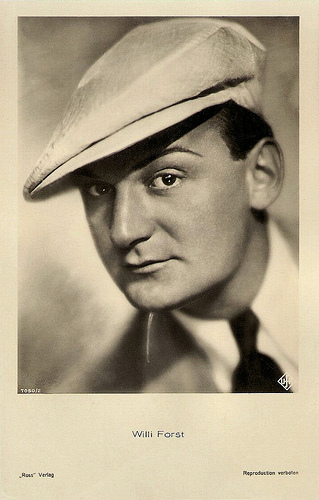
German postcard by Ross Verlag, no. 7050/2, 1932-1933. Photo: Ufa.
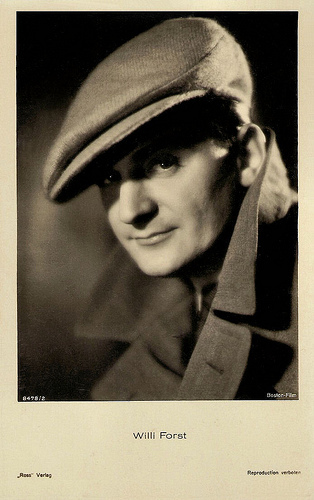
German postcard by Ross Verlag, no. 8478/2, 1933-1934. Photo: Boston-Film.
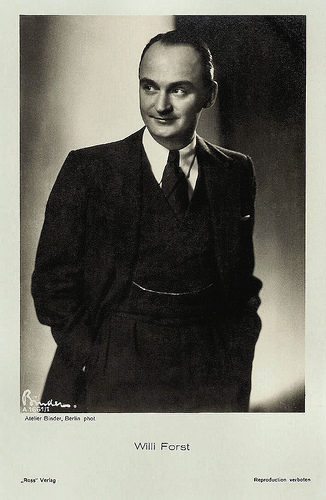
German postcard by Ross Verlag, no. A 1661/1, 1937-1938. Photo: Alex Binder, Berlin.
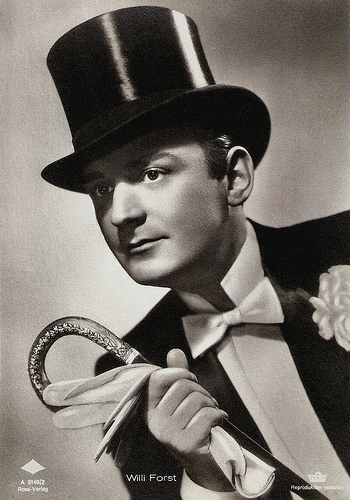
German postcard by Ross Verlag, no. A 3149/2, 1941-1944. Photo: Tobis.
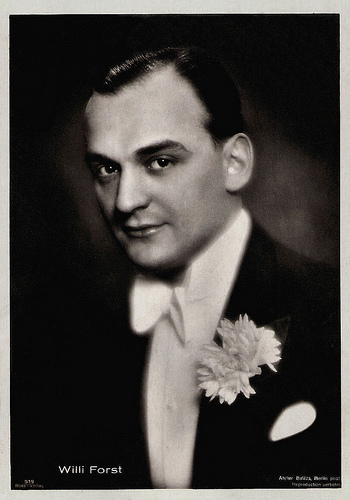
German postcard by Ross Verlag, no. 519, 1941-1944. Photo: Atelier Balázs, Berlin.
Marlene Dietrich
Willi (also written as Willy) Forst was born as Wilhelm Anton Frohs in Vienna, Austria-Hungary (now Austria), in 1903.
At age 16, he began his career as an actor on the provincial stages in the Austria–Hungary and the German Empire, and appeared as a featured performer in the post World War I operetta theatres of Vienna and Berlin.
He also worked with famous directors like Erwin Piscator and Max Reinhardt. He made his film debut in the Austrian film Der Wegweiser/The Signpost (Hans Kottow, 1920).
His first major screen roles were opposite Marlene Dietrich in the silent films Café Elektric/Cafe Electric (Gustav Ucicky, 1927) and Gefahren der Brautzeit/Dangers of the Engagement Period (Fred Sauer, 1929).
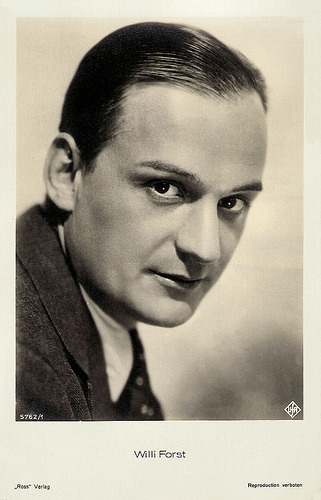
German postcard by Ross Verlag, no. 5762/1, 1930-1931. Photo: Ufa.
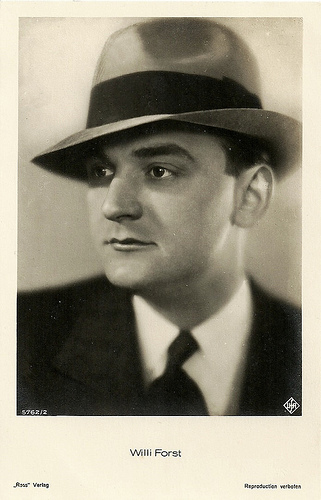
German postcard by Ross Verlag, no. 5762/2, 1930-1931. Photo: Ufa.
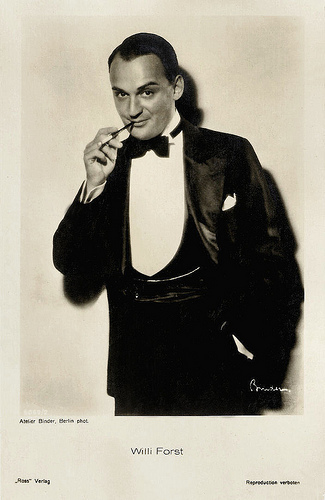
German postcard by Ross Verlag, no. 6069/2 1931-1932. Photo: Atelier Binder, Berlin.
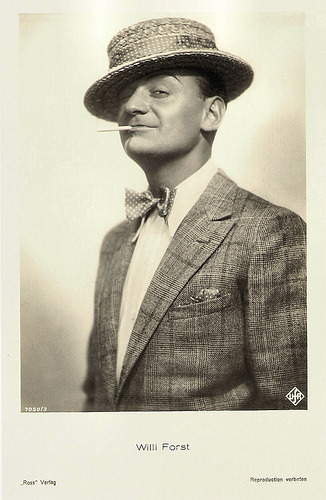
German postcard by Ross Verlag, no. 7050/3, 1932-1933. Photo: Ufa.
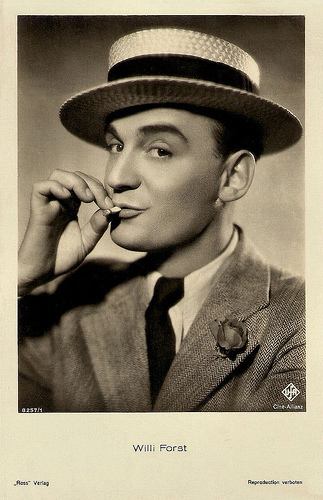
Greman postcard by Ross Verlag, no. 8257/1, 1933-1934. Photo: Ufa / Cine-Allianz.
Velvety Voice
Willi Forst made his sound and singing film debut in Atlantik/Titanic (Ewald André Dupont, 1929) and soon became known for his distinctive velvety voice and 'charming Viennese' characters.
After Zwei Herzen im 3/4 Takt/Two Hearts in Waltz Time (Géza von Bolváry, 1930), he played six more times under the direction of Géza von Bolváry.
Most of these successes were written by Walter Reisch, and so were also Ein blonder Traum/A Blonde's Dream (Paul Martin, 1932) with Lilian Harvey and Willy Fritsch , and Der Prinz von Arkadien/The Prince from Arcadien (Karl Hartl, 1932) with Liane Haid .
Forst considered the best learning experience for his future role as director, So ein Mädel vergisst man nicht/Unforgettable Girl (1933) directed by expressionist film actor-turned-director Fritz Kortner .
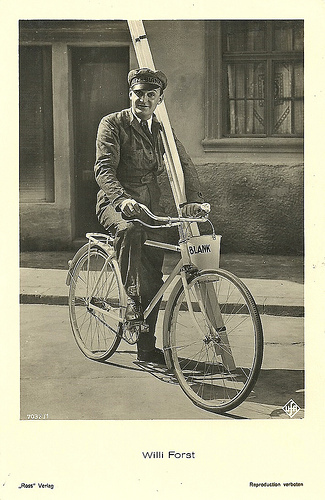
German postcard by Ross Verlag, no. 7032/1, 1932-1933. Photo: Ufa. Publicity still for Ein blonder Traum/Happy Ever After (Paul Martin, 1932).
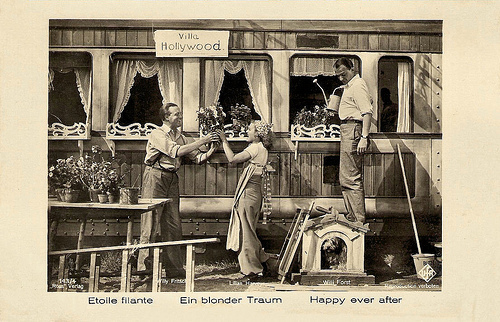
German postcard by Ross Verlag, no. 143/4, 1931-1932. Photo: Ufa. Publicity still for Ein blonder Traum/Happy Ever After (Paul Martin, 1932).
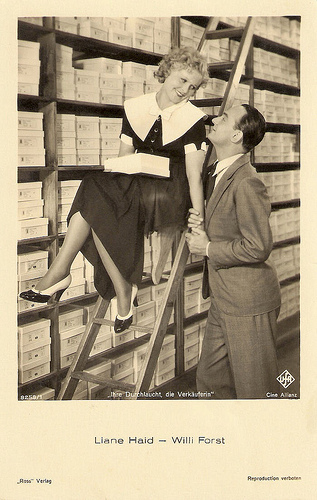
German postcard by Ross Verlag, no. 8258/1, 1933-1934. Photo: Ufa / Cine Allianz. Publicity still for the romantic comedy Ihre Durchlaucht, die Verkäuferin/Her Excellency, the Salesgirl (Karl Hartl, 1933) with Liane Haid .
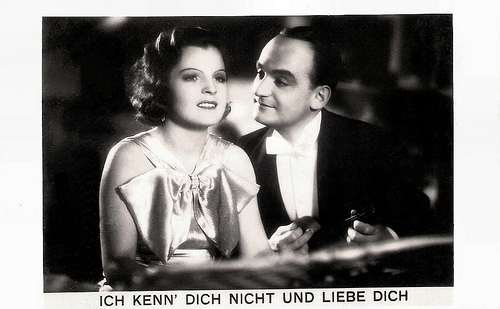
British postcard. Photo: publicity still for Ich Kenn Dich Nicht Und Liebe Dich/I Don't Know You, But I Love You (Géza von Bolváry, 1934).
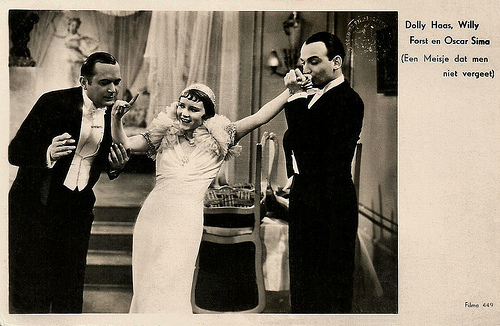
Dutch postcard by Filma, no. 449. Photo: Dolly Haas , Willi Forst and Oskar Sima in So ein Mädel vergisst man nicht (1932).
Bel Ami
Willi Forst developed the genre of the Wiener Filme with writer Walter Reisch in the 1930s, beginning with the Franz Schubert melodrama Leise flehen meine Lieder/Lover Divine (Willi Forst, 1933).
He followed it with the hit Maskerade/Masquerade in Vienna (Willi Forst, 1934), which launched his fame as a significant director and made an instant star of Paula Wessely .
For Mazurka (Willi Forst, 1935), he lured Pola Negri back from Hollywood.
From the mid-1930s he also recorded many records, largely of sentimental Viennese songs, for the Odeon Records label owned by Carl Lindström AG.
He founded his own film company, Willi Forst-Film, in 1937. His best known film would be the elegant satire Bel Ami (Willi Forst, 1939) based on the novel by Guy de Maupassant. He also played the title role, which would be his alter ego from then on.
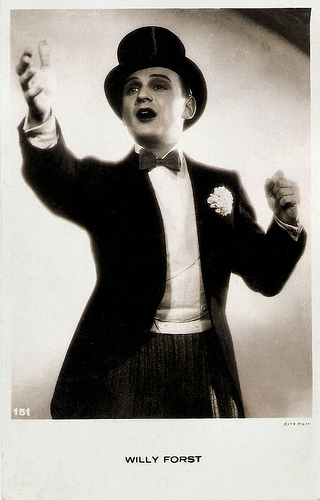
Dutch Postcard by City Film, no. 151.
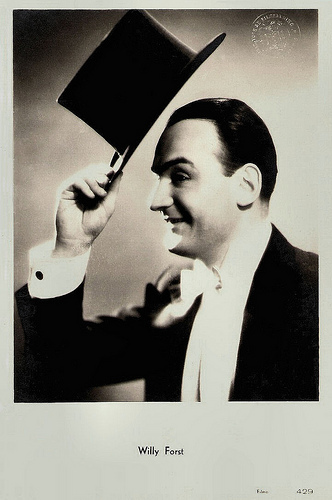
Dutch Postcard by JosPe, Arnhem, no. 429. Photo: Filma.
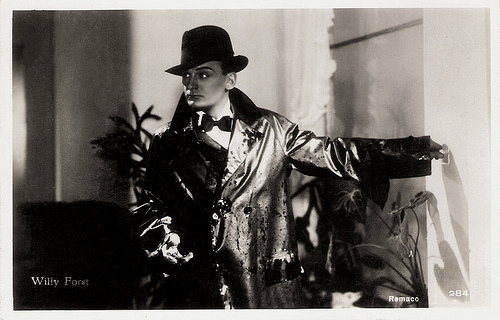
Dutch postcard by JosPe, Arnhem, no. 984. Photo: Remaco.
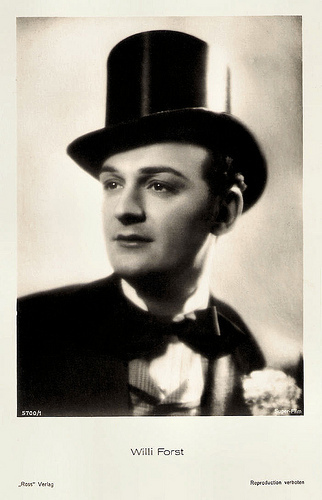
German postcard by Ross Verlag, no. 5700/1, 1930-1931. Photo: Super-Film.
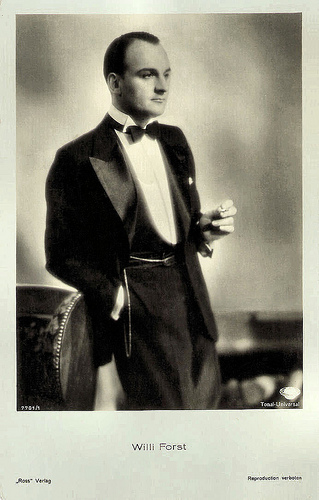
German postcard by Ross Verlag, no. 7701/1, 1932-1933. Photo: Tonal - Universal. Publicity still for Brennendes Geheimnis/The Burning Secret (Robert Siodmak, 1933).
Wiener Filme
Following the annexation of Austria in 1938, Willi Forst was much courted by the Nazis. He succeeded in avoiding overt political statements, concentrating entirely on the light entertainment for which he was famous and which was much in demand during the war.
During the seven year period of National Socialist rule in Austria, he only made four films, none of them political. His most important work was his Wien-Film trilogy: Operette/Operetta (Willi Forst, 1940), Wiener Blut/Vienna Blood (Willi Forst, 1942), and Wiener Mädeln/Vienna Beauties (Willi Forst, begun in 1944, but not completed until 1949).
After the war he had comparatively little success, with the exception of the film Die Sünderin/The Sinner (Willi Forst, 1951) starring Hildegard Knef and Gustav Fröhlich. The frank treatment of social and sexual mores in Germany during and after the war ánd a modest nude scene of Knef created a furor at the release, but the film went on to attract an audience of seven million people.
Willi Forst's last film was the comedy Wien, du Stadt meiner Träume/Vienna, City of My Dreams (Willi Forst, 1957), with Adrian Hoven and Erika Remberg .
Then Willi Forst retired from the film world, acknowledging that his style was no longer in demand. After the death of his wife in 1973 he lived a reclusive life in the Swiss canton of Tessin. He died of cancer in Vienna in 1980 and is buried in Neustift am Walde.
At Senses of Cinema, professor Robert von Dassanowsky writes that Forst is "one of Austrian and Central European cinema's greatest filmmakers and influential industry figures, whose lack of presence in the international film 'canon' of important directors today is one more casualty from the negligence that has greeted Austrian cinema since the collapse of its commercial film industry in the 1960's."
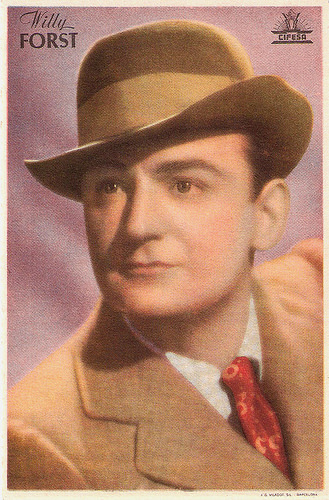
Spanish collector's card by I.G. Viladot, Barcelona. Image: Cifesa.
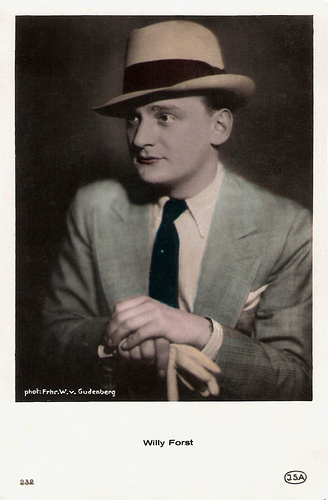
Dutch postcard by JSA, no. 232. Photo: Freiherr Wolff von Gudenberg. [Baron] Wolff von Gudenberg (1890-1961) was a noted and fashionable photographer in the 1920s and 1930s.
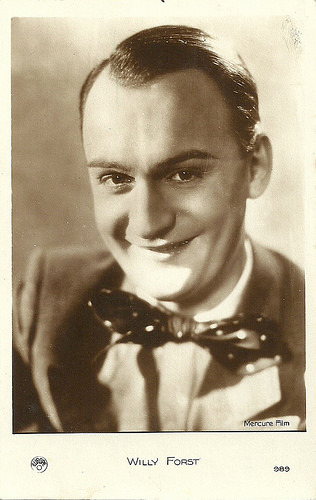
French postcard by Europe, no. 989. Photo: Mercure Film.
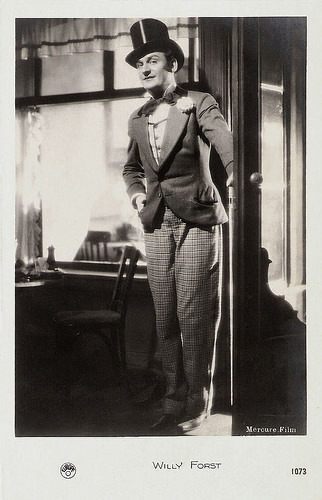
French postcard by Europe, no. 1073. Photo: Mercure Film.
Sources: Robert von Dassanowsky (Senses of Cinema), Thomas Staedeli (Cyranos), Filmportal.de, Wikipedia and .

German postcard by Ross Verlag, no. 7050/2, 1932-1933. Photo: Ufa.

German postcard by Ross Verlag, no. 8478/2, 1933-1934. Photo: Boston-Film.

German postcard by Ross Verlag, no. A 1661/1, 1937-1938. Photo: Alex Binder, Berlin.

German postcard by Ross Verlag, no. A 3149/2, 1941-1944. Photo: Tobis.

German postcard by Ross Verlag, no. 519, 1941-1944. Photo: Atelier Balázs, Berlin.
Marlene Dietrich
Willi (also written as Willy) Forst was born as Wilhelm Anton Frohs in Vienna, Austria-Hungary (now Austria), in 1903.
At age 16, he began his career as an actor on the provincial stages in the Austria–Hungary and the German Empire, and appeared as a featured performer in the post World War I operetta theatres of Vienna and Berlin.
He also worked with famous directors like Erwin Piscator and Max Reinhardt. He made his film debut in the Austrian film Der Wegweiser/The Signpost (Hans Kottow, 1920).
His first major screen roles were opposite Marlene Dietrich in the silent films Café Elektric/Cafe Electric (Gustav Ucicky, 1927) and Gefahren der Brautzeit/Dangers of the Engagement Period (Fred Sauer, 1929).

German postcard by Ross Verlag, no. 5762/1, 1930-1931. Photo: Ufa.

German postcard by Ross Verlag, no. 5762/2, 1930-1931. Photo: Ufa.

German postcard by Ross Verlag, no. 6069/2 1931-1932. Photo: Atelier Binder, Berlin.

German postcard by Ross Verlag, no. 7050/3, 1932-1933. Photo: Ufa.

Greman postcard by Ross Verlag, no. 8257/1, 1933-1934. Photo: Ufa / Cine-Allianz.
Velvety Voice
Willi Forst made his sound and singing film debut in Atlantik/Titanic (Ewald André Dupont, 1929) and soon became known for his distinctive velvety voice and 'charming Viennese' characters.
After Zwei Herzen im 3/4 Takt/Two Hearts in Waltz Time (Géza von Bolváry, 1930), he played six more times under the direction of Géza von Bolváry.
Most of these successes were written by Walter Reisch, and so were also Ein blonder Traum/A Blonde's Dream (Paul Martin, 1932) with Lilian Harvey and Willy Fritsch , and Der Prinz von Arkadien/The Prince from Arcadien (Karl Hartl, 1932) with Liane Haid .
Forst considered the best learning experience for his future role as director, So ein Mädel vergisst man nicht/Unforgettable Girl (1933) directed by expressionist film actor-turned-director Fritz Kortner .

German postcard by Ross Verlag, no. 7032/1, 1932-1933. Photo: Ufa. Publicity still for Ein blonder Traum/Happy Ever After (Paul Martin, 1932).

German postcard by Ross Verlag, no. 143/4, 1931-1932. Photo: Ufa. Publicity still for Ein blonder Traum/Happy Ever After (Paul Martin, 1932).

German postcard by Ross Verlag, no. 8258/1, 1933-1934. Photo: Ufa / Cine Allianz. Publicity still for the romantic comedy Ihre Durchlaucht, die Verkäuferin/Her Excellency, the Salesgirl (Karl Hartl, 1933) with Liane Haid .

British postcard. Photo: publicity still for Ich Kenn Dich Nicht Und Liebe Dich/I Don't Know You, But I Love You (Géza von Bolváry, 1934).

Dutch postcard by Filma, no. 449. Photo: Dolly Haas , Willi Forst and Oskar Sima in So ein Mädel vergisst man nicht (1932).
Bel Ami
Willi Forst developed the genre of the Wiener Filme with writer Walter Reisch in the 1930s, beginning with the Franz Schubert melodrama Leise flehen meine Lieder/Lover Divine (Willi Forst, 1933).
He followed it with the hit Maskerade/Masquerade in Vienna (Willi Forst, 1934), which launched his fame as a significant director and made an instant star of Paula Wessely .
For Mazurka (Willi Forst, 1935), he lured Pola Negri back from Hollywood.
From the mid-1930s he also recorded many records, largely of sentimental Viennese songs, for the Odeon Records label owned by Carl Lindström AG.
He founded his own film company, Willi Forst-Film, in 1937. His best known film would be the elegant satire Bel Ami (Willi Forst, 1939) based on the novel by Guy de Maupassant. He also played the title role, which would be his alter ego from then on.

Dutch Postcard by City Film, no. 151.

Dutch Postcard by JosPe, Arnhem, no. 429. Photo: Filma.

Dutch postcard by JosPe, Arnhem, no. 984. Photo: Remaco.

German postcard by Ross Verlag, no. 5700/1, 1930-1931. Photo: Super-Film.

German postcard by Ross Verlag, no. 7701/1, 1932-1933. Photo: Tonal - Universal. Publicity still for Brennendes Geheimnis/The Burning Secret (Robert Siodmak, 1933).
Wiener Filme
Following the annexation of Austria in 1938, Willi Forst was much courted by the Nazis. He succeeded in avoiding overt political statements, concentrating entirely on the light entertainment for which he was famous and which was much in demand during the war.
During the seven year period of National Socialist rule in Austria, he only made four films, none of them political. His most important work was his Wien-Film trilogy: Operette/Operetta (Willi Forst, 1940), Wiener Blut/Vienna Blood (Willi Forst, 1942), and Wiener Mädeln/Vienna Beauties (Willi Forst, begun in 1944, but not completed until 1949).
After the war he had comparatively little success, with the exception of the film Die Sünderin/The Sinner (Willi Forst, 1951) starring Hildegard Knef and Gustav Fröhlich. The frank treatment of social and sexual mores in Germany during and after the war ánd a modest nude scene of Knef created a furor at the release, but the film went on to attract an audience of seven million people.
Willi Forst's last film was the comedy Wien, du Stadt meiner Träume/Vienna, City of My Dreams (Willi Forst, 1957), with Adrian Hoven and Erika Remberg .
Then Willi Forst retired from the film world, acknowledging that his style was no longer in demand. After the death of his wife in 1973 he lived a reclusive life in the Swiss canton of Tessin. He died of cancer in Vienna in 1980 and is buried in Neustift am Walde.
At Senses of Cinema, professor Robert von Dassanowsky writes that Forst is "one of Austrian and Central European cinema's greatest filmmakers and influential industry figures, whose lack of presence in the international film 'canon' of important directors today is one more casualty from the negligence that has greeted Austrian cinema since the collapse of its commercial film industry in the 1960's."

Spanish collector's card by I.G. Viladot, Barcelona. Image: Cifesa.

Dutch postcard by JSA, no. 232. Photo: Freiherr Wolff von Gudenberg. [Baron] Wolff von Gudenberg (1890-1961) was a noted and fashionable photographer in the 1920s and 1930s.

French postcard by Europe, no. 989. Photo: Mercure Film.

French postcard by Europe, no. 1073. Photo: Mercure Film.
Sources: Robert von Dassanowsky (Senses of Cinema), Thomas Staedeli (Cyranos), Filmportal.de, Wikipedia and .
Published on December 05, 2015 22:00
December 4, 2015
Imported from the USA: Dorothy Hyson
American actress Dorothy Hyson (1914–1996) led a successful stage and film career in London. Noted for her great beauty and striking looks, the songwriters Rogers and Hart dedicated their song, The Most Beautiful Girl in the World, to her. She was a byword for theatrical West End glamour, but also worked as a cryptographer for the secret service during the war.
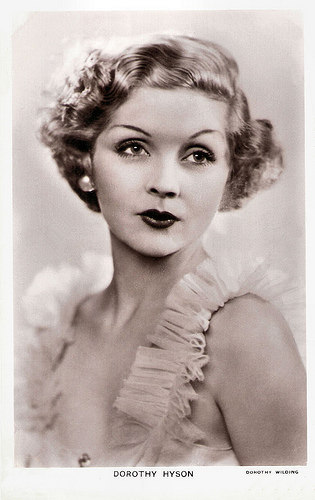
British postcard in the Picturegoer Series, London, no. 785a. Photo: Dorothy Wilding.
The comedienne of the future
Dorothy Hyson was born Dorothy Wardell Heisen in Chicago, Illinois, in 1914. She was the daughter of adorable Dorothy Dickson, the toast of Broadway and her husband, Carl Hyson, celebrated exponent of ballroom dancing in an era when it was all the rage.
As a child, young Dorothy appeared in the silent Hollywood film Paying the Piper (George Fitzmaurice, 1921) which starred her mother. That same year, the family moved to London where her parents went to work at the West End.
She made her London stage debut at the age of 12 at the Savoy Theatre in J.M. Barrie's Quality Street. The following year, she acted in Daisy Ashford's The Young Visitors. Leading critic James Agate wrote: "I think in Dorothy Hyson we may have the comedienne of the future".
In 1933, Ivor Novello , impressed by her charm and beauty, offered her the role of Gladys Cooper 's daughter in his play, Flies in the Sun. Later successes included Maxwell Anderson's comedy, Saturday's Children and Touch Wood, in which she co-starred with Flora Robson.
She made her film debut in the British historical comedy Soldiers of the King (Maurice Elvey, 1933) starring Cicely Courtneidge . Then she co-starred in the British horror film The Ghoul (T. Hayes Hunter, 1933), starring Boris Karloff, Cedric Hardwicke, Ernest Thesiger, and Ralph Richardson , making his film debut. An Egyptologist (Karloff of course) returns from the dead to take revenge on those who have violated his tomb. The film was popular in the UK but performed disappointingly in the US. Subsequently, it disappeared and was considered to be a lost film over the next 31 years.
Hyson also appeared in British films like the musical That's a Good Girl (Jack Buchanan, 1933), the Aldwych farce Turkey Time (Tom Walls, 1933) starring Tom Walls and Ralph Lynn , and the musical Sing As We Go (Basil Dean, 1934) starring Gracie Fields .
However, acting in films by day and on stage at night brought on a nervous breakdown. She brought her film career to a temporary halt. In 1935, she appeared at the West End in the play, The Ringmaster, with Laurence Olivier . And at the age of 20, she married the British film actor Robert Douglas.
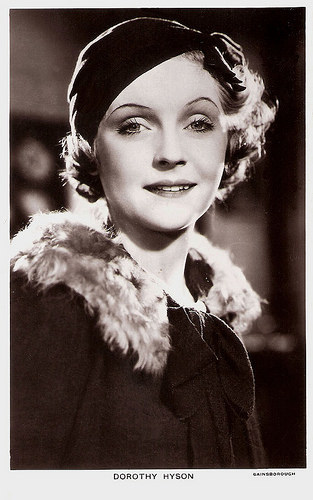
British postcard in the Picturegoer Series, London, no. 785. Photo: Gainsborough.
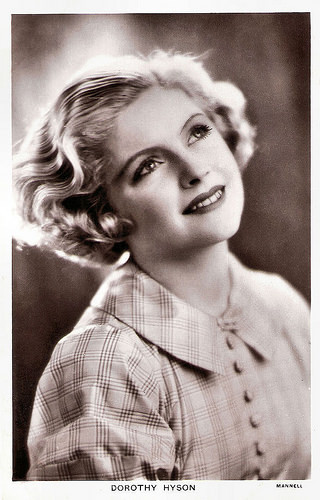
British postcard in the Picturegoer Series, London, no. 846. Photo: Mannell.
Secret codebreaking
In 1940, Dorothy Hyson starred with George Formby in the film Spare a Copper (John Paddy Carstairs, 1940), a combination of musical comedy and war film. Formby plays a bumbling War Reservist police officer called George Carter who aspires to become a member of the flying squad. The film is set in Merseyside where the battleship HMS Hercules is being built.
She also co-starred with Robert Morley in You Will Remember (Jack Raymond, 1941).
During World War II, Hyson worked as a cryptographer at the secret codebreaking establishment Bletchley Park. Though married to actor Robert Douglas at the time, she was visited there by actor and director Anthony Quayle and the two fell in love.
After the war, she returned to the West End. She joined John Gielgud ’s Haymarket Company in 1945. Her final screen appearance was opposite Margaret Rutherford in the TV Movie The Importance of Being Earnest (1946) based on the play by Oscar Wilde.
After divorcing Douglas, she married Quayle in 1947. Then she soon retired from the stage to concentrate on bringing up their children. They had two daughters, actress Jenny Quayle and Rosanna Rosanna Astley-Quayle, and a son, designer Christopher Quayle. Hyson was a renowned hostess in London and numbered among her close friends, H.M. Queen Elizabeth II, Queen Elizabeth the Queen Mother, Noel Coward and John Gielgud .
Dorothy Hyson was widowed in 1989. She died from a stroke in England, in 1996, a year after the death of her mother, who died at age 102. Wikipedia writes that it is not known whether Hyson ever relinquished her American citizenship and/or became a British subject.
Dorothy Hyson sings Sun In My Eyes in Turkey Time (1933). Source: gallerydreams (YouTube).
George Formby sings On The Beat in Spare a Copper (1940). Source: mkcwebmaster (YouTube).
Sources: Adam Benedick (The Independent), (IMDb), Dave Miller (Flickr), Wikipedia and .

British postcard in the Picturegoer Series, London, no. 785a. Photo: Dorothy Wilding.
The comedienne of the future
Dorothy Hyson was born Dorothy Wardell Heisen in Chicago, Illinois, in 1914. She was the daughter of adorable Dorothy Dickson, the toast of Broadway and her husband, Carl Hyson, celebrated exponent of ballroom dancing in an era when it was all the rage.
As a child, young Dorothy appeared in the silent Hollywood film Paying the Piper (George Fitzmaurice, 1921) which starred her mother. That same year, the family moved to London where her parents went to work at the West End.
She made her London stage debut at the age of 12 at the Savoy Theatre in J.M. Barrie's Quality Street. The following year, she acted in Daisy Ashford's The Young Visitors. Leading critic James Agate wrote: "I think in Dorothy Hyson we may have the comedienne of the future".
In 1933, Ivor Novello , impressed by her charm and beauty, offered her the role of Gladys Cooper 's daughter in his play, Flies in the Sun. Later successes included Maxwell Anderson's comedy, Saturday's Children and Touch Wood, in which she co-starred with Flora Robson.
She made her film debut in the British historical comedy Soldiers of the King (Maurice Elvey, 1933) starring Cicely Courtneidge . Then she co-starred in the British horror film The Ghoul (T. Hayes Hunter, 1933), starring Boris Karloff, Cedric Hardwicke, Ernest Thesiger, and Ralph Richardson , making his film debut. An Egyptologist (Karloff of course) returns from the dead to take revenge on those who have violated his tomb. The film was popular in the UK but performed disappointingly in the US. Subsequently, it disappeared and was considered to be a lost film over the next 31 years.
Hyson also appeared in British films like the musical That's a Good Girl (Jack Buchanan, 1933), the Aldwych farce Turkey Time (Tom Walls, 1933) starring Tom Walls and Ralph Lynn , and the musical Sing As We Go (Basil Dean, 1934) starring Gracie Fields .
However, acting in films by day and on stage at night brought on a nervous breakdown. She brought her film career to a temporary halt. In 1935, she appeared at the West End in the play, The Ringmaster, with Laurence Olivier . And at the age of 20, she married the British film actor Robert Douglas.

British postcard in the Picturegoer Series, London, no. 785. Photo: Gainsborough.

British postcard in the Picturegoer Series, London, no. 846. Photo: Mannell.
Secret codebreaking
In 1940, Dorothy Hyson starred with George Formby in the film Spare a Copper (John Paddy Carstairs, 1940), a combination of musical comedy and war film. Formby plays a bumbling War Reservist police officer called George Carter who aspires to become a member of the flying squad. The film is set in Merseyside where the battleship HMS Hercules is being built.
She also co-starred with Robert Morley in You Will Remember (Jack Raymond, 1941).
During World War II, Hyson worked as a cryptographer at the secret codebreaking establishment Bletchley Park. Though married to actor Robert Douglas at the time, she was visited there by actor and director Anthony Quayle and the two fell in love.
After the war, she returned to the West End. She joined John Gielgud ’s Haymarket Company in 1945. Her final screen appearance was opposite Margaret Rutherford in the TV Movie The Importance of Being Earnest (1946) based on the play by Oscar Wilde.
After divorcing Douglas, she married Quayle in 1947. Then she soon retired from the stage to concentrate on bringing up their children. They had two daughters, actress Jenny Quayle and Rosanna Rosanna Astley-Quayle, and a son, designer Christopher Quayle. Hyson was a renowned hostess in London and numbered among her close friends, H.M. Queen Elizabeth II, Queen Elizabeth the Queen Mother, Noel Coward and John Gielgud .
Dorothy Hyson was widowed in 1989. She died from a stroke in England, in 1996, a year after the death of her mother, who died at age 102. Wikipedia writes that it is not known whether Hyson ever relinquished her American citizenship and/or became a British subject.
Dorothy Hyson sings Sun In My Eyes in Turkey Time (1933). Source: gallerydreams (YouTube).
George Formby sings On The Beat in Spare a Copper (1940). Source: mkcwebmaster (YouTube).
Sources: Adam Benedick (The Independent), (IMDb), Dave Miller (Flickr), Wikipedia and .
Published on December 04, 2015 22:00
Paul van Yperen's Blog
- Paul van Yperen's profile
- 13 followers
Paul van Yperen isn't a Goodreads Author
(yet),
but they
do have a blog,
so here are some recent posts imported from
their feed.



